Forums
- Forums
- Duggy's Reference Hangar
- USAAF / USN Library
- North American B-45 Tornado
North American B-45 Tornado
Post a reply
- Go to Previous topic
- Go to Next topic
- Go to Welcome
- Go to Introduce Yourself
- Go to General Discussion
- Go to Screenshots, Images and Videos
- Go to Off topic
- Go to Works in Progress
- Go to Skinning Tips / Tutorials
- Go to Skin Requests
- Go to IJAAF Library
- Go to Luftwaffe Library
- Go to RAF Library
- Go to USAAF / USN Library
- Go to Misc Library
- Go to The Ops Room
- Go to Made in Germany
- Go to Campaigns and Missions
- Go to Works in Progress
- Go to Juri's Air-Raid Shelter
- Go to Campaigns and Missions
- Go to Works in Progress
- Go to Skinpacks
- Go to External Projects Discussion
- Go to Books & Resources
-
2 years agoMon Dec 25 2023, 01:32pmDuggy
 Main AdminNorth American XB-45 Tornado
Main AdminNorth American XB-45 Tornado
The North American B-45 Tornado was the first operational jet bomber to be used by the USAF. It was also the first jet aircraft to be refuelled in the air and was the first jet bomber to drop a nuclear weapon. For a couple of years during the early and mid-1950s, the B-45 Tornado was a key element in the US nuclear deterrent. Unfortunately, the B-45 was rather limited in its nuclear carrying capability, but proved to be a first-rate reconnaissance aircraft. Nevertheless, the Tornado was rapidly eclipsed in performance and capability by more advanced designs such as the Boeing B-47 Stratojet, and its service with the USAF was relatively brief.
The B-45 officially originated back in August 1944, at a time when the USAAF was already aware of German advances in the field of jet propulsion, especially as applied to the development of jet bombers. Alarmed by German developments, the War Department called for bids from the aviation industry on a new family of jet-powered bombers, with gross weights ranging from 80,000 pounds to more than 200,000 pounds. Requirements for a top speed of 500 mph, a 1000-mile combat radius, and service ceiling of at least 40,000 feet were also issued. These new aircraft were to be powered either by TG-180 or TG-190 engines which were then under development at General Electric. The TG-180 was eventually built by the Allison Division of General Motors as the J35, and the TG-190 was built by the General Electric company as the J47.
In 1944, North American Aviation of Inglewood, California submitted a design known under the company designation NA-130 as its proposal in response to the War Department request. The NA-130 was a shoulder-wing monoplane of fairly conventional layout with a dihedral tailplane and a retractable landing gear. The Model 130 was to be powered by four turbojets, grouped in horizontal pairs, one pair under the wings on each side of the fuselage outboard of the tailplane.
A Letter Contract dated September 8, 1944 called for the development of three experimental aircraft based on the NA-130. The designation XB-45 was assigned. At the same time, three other contractors were also awarded development contracts, Convair for the XB-46, Boeing for the XB-47, and Martin for the XB-48.
The end of the Second World War resulted in the cancellation of many projects and the delay of others. However, the War Department felt that the development of a jet-powered bomber should still be pressed forward with the utmost speed, and the XB-45, XB-46, XB-47, and XB-48 contracts were left untouched. In 1946, rising tensions with its erstwile Soviet ally caused the USAAF to assign a high priority to the development of a jet-powered bomber. In response to this new sense of urgency, the USAAF decided to forego the competition that would ordinarily be held between the four entries and opted instead to review the available designs to see which of the contestants could be produced first.
By mid-1946, the XB-45 and XB-46 were nearing completion, but the XB-47 and XB-48 were still at least two more years away. Since the USAAF was guided by what it felt to be a sense of great urgency, it decided to appraise the XB-45 and XB-46 right away and choose one of them for immediate production. Any consideration of the XB-47 and XB-48 would be deferred until after they had flown. if either the XB-47 or XB-48 turned out to be markedly superior to the plane that was then being produced, then that aircraft would be purchased and the currently-produced version would be phased out. This is indeed what happened when the XB-47 appeared.
The USAAF concluded that the Convair XB-46 would likely be inferior in performance to the XB-45, and that its thin, graceful fuselage would not be able to hold all the required radar equipment. Since the configuration of the XB-45 did not depart significantly from that of proven aircraft already in service and hence presented fewer risks, on August 2, 1946, the USAAF announced that they were going to endorse the immediate production of the B-45. A contract for 96 B-45As (North American N-147) was signed on January 20, 1947, even before the XB-45 had made its first flight.
The XB-45 was a shoulder-winged monoplane powered by four Allison-built General Electric J35-A-4 turbojets paired side-by-side in large nacelles underneath each wing. The tailplane had a large dihedral angle in order to clear the jet exhaust. The crew consisted of two pilots sitting in tandem underneath a transparent canopy, a bombardier in a transparent nose, and a gunner sitting in the extreme tail. It was assumed that jet bombers would be so fast that only the tail of the aircraft needed to be defended. The three forward crew members entered the aircraft by means of a large door on the left hand side of the nose, with the tail gunner having his own door in the right fuselage underneath the tailplane. The main landing gear was mounted just inboard of the engine nacelles, and retracted inward into wells in the wing roots.
The first XB-45 took off on its maiden flight on March 17, 1947 from Muroc Army Air Field, piloted by George Krebs. The aircraft did not have a greenhouse bombardier's compartment, but a fake greenhouse was painted on the nose. On that first flight, the aircraft had to be flown under severe speed restrictions, since the landing gear doors would not close properly. It was the first American four-jet bomber to fly.
Three XB-45s were built. Each of the three XB-45s was instrumented for a different specialized phase of the program. Near the beginning of the test flight program, one of the XB-45s crashed, killing two of North American's test pilots. A total of 131 flights were carried out by the surviving two aircraft before they were turned over to the USAF.
The USAF accepted one of the surviving XB-45s on July 30, 1948, the other on August 31. Initially, they did not have cabin pressurization, but this was later added. In June of 1949, one of the XB-45s was damaged beyond repair in an accident. The remaining XB-45 had only a limited testing value due to an initial shortage in government-furnished equipment. A USAF flight test crew delivered the plane to the Wright- Patterson AFB in Ohio, where equipment was installed for bombing tests at Muroc AFB in California, but very few tests were actually carried out because of excessive maintenance requirements. On May 15, 1950 the aircraft was transferred to the Air Training Command to serve as a ground trainer.
Serials of XB-45 Tornado
45-59479/59481 North American XB-45 Tornado
Specification of North American XB-45 Tornado:
Engines: Four Allison J35-A-7 turbojets, rated at 4000 lb.s.t. each. Performance: Maximum speed 483 mph at 30,000 feet, 516 mph at 14,000 feet, 494 mph at sea level. Service ceiling 37,600 fet. Initial climb rate 2070 feet per minute. An altitude of 30,000 feet could be attained in 19 minutes. 2236 miles range with 8350 pounds of bombs, 1700 miles range with 14,000 pounds of bombs. Maximum range 2921 miles. Weights: 41,876 pounds, 66,820 pounds gross, 82,600 pounds maximum. Dimensions: Wingspan 89 feet 6 inches, length 74 feet 0 inches, height 25 feet 2 inches, wing area 1175 square feet.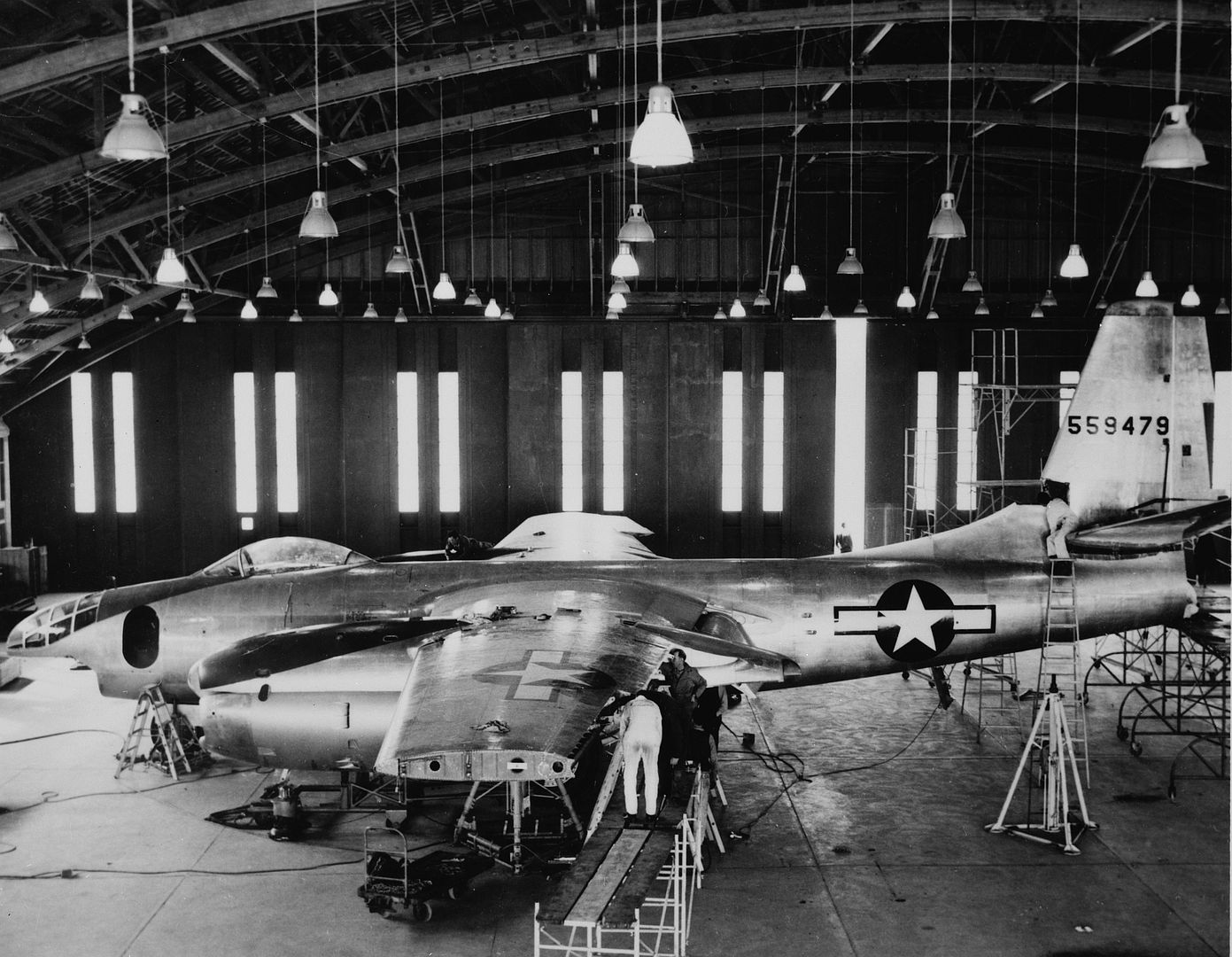
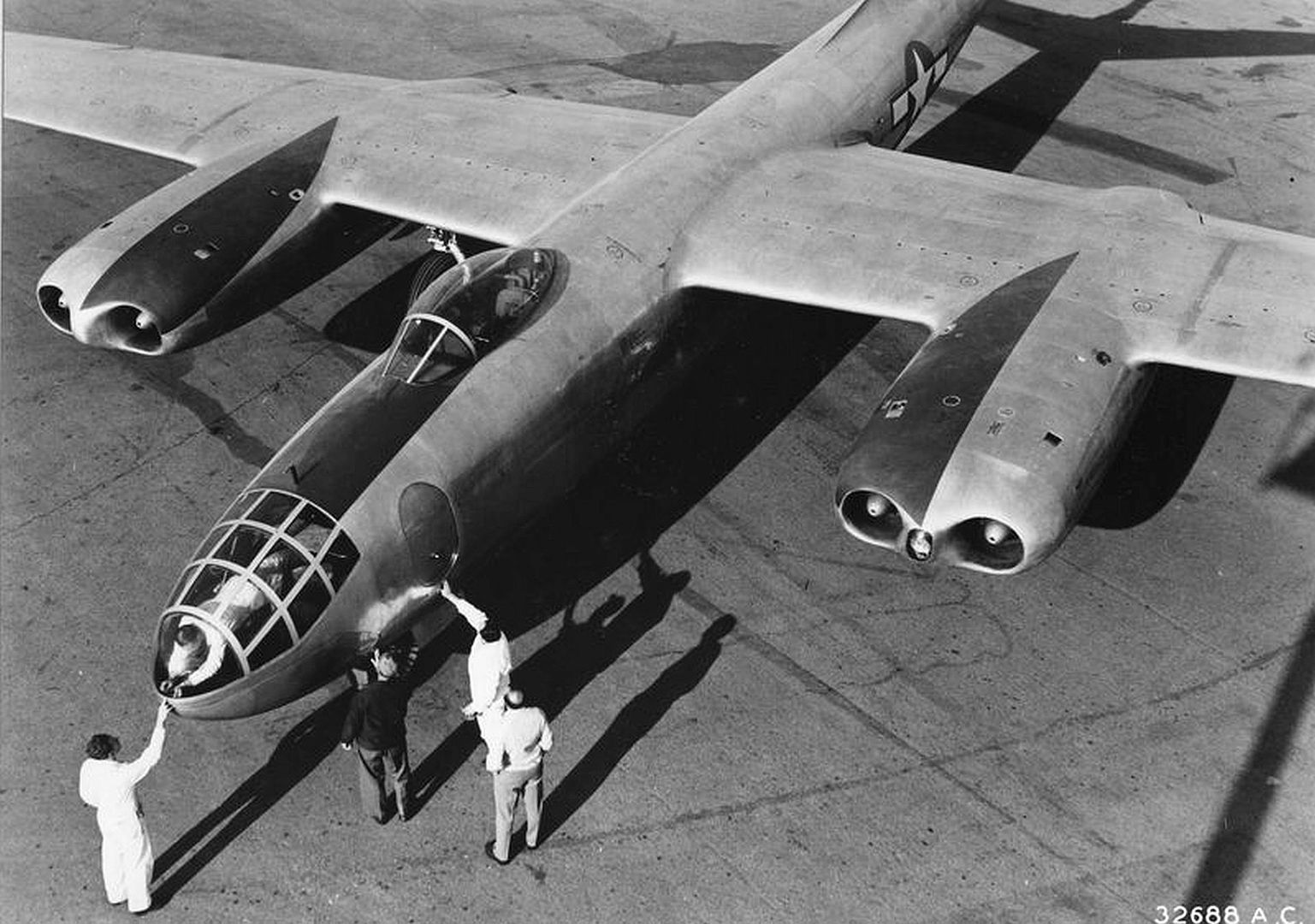
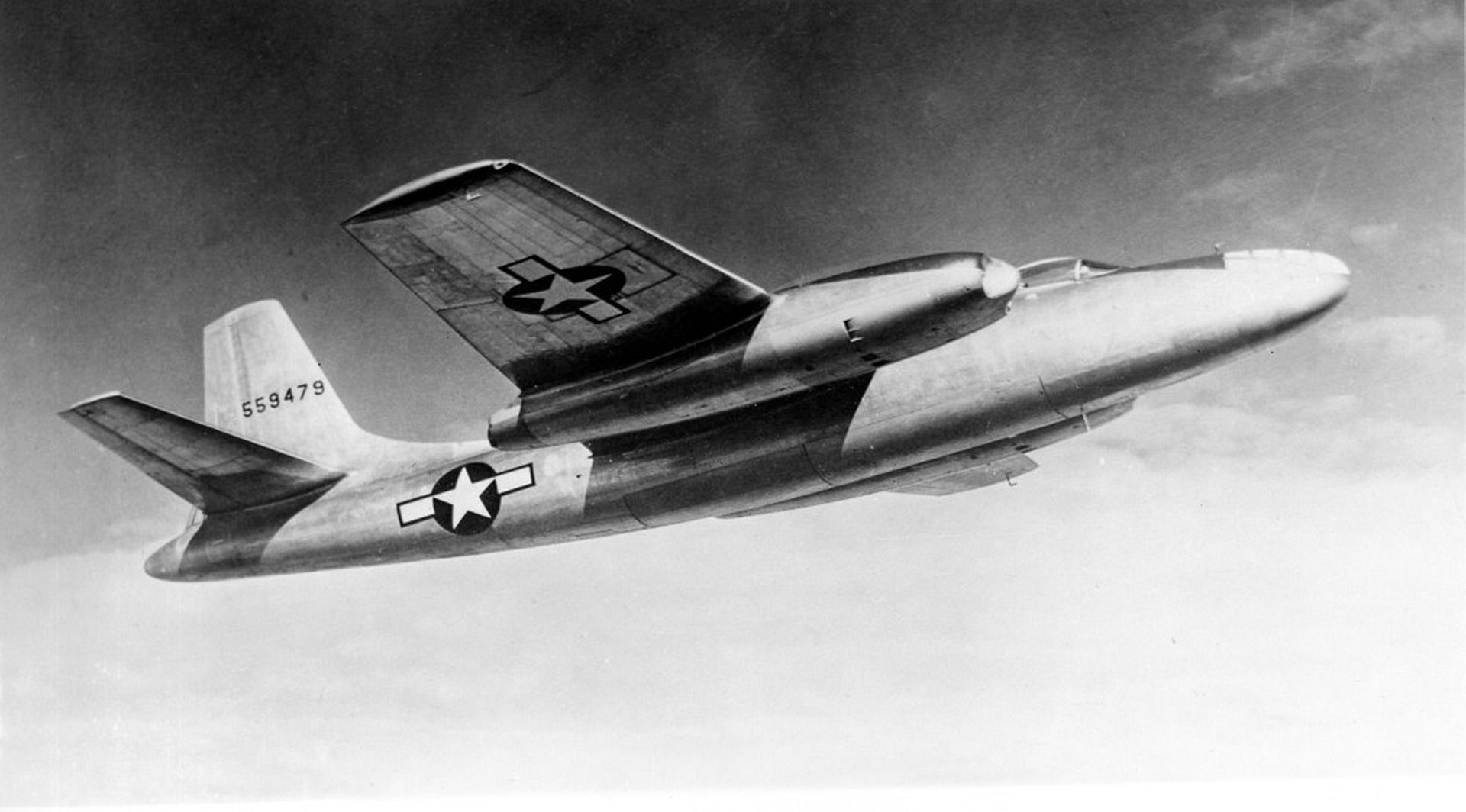
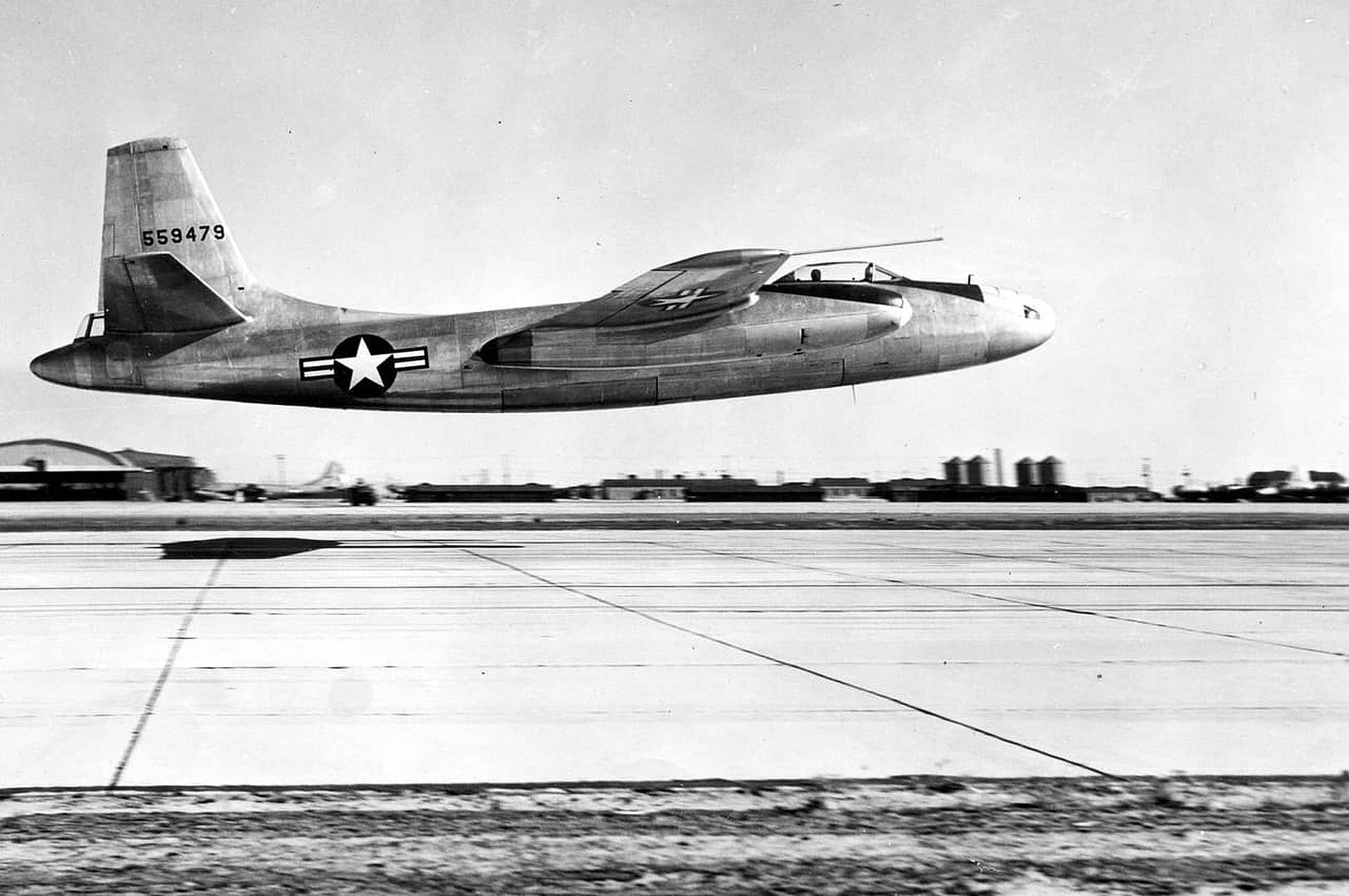
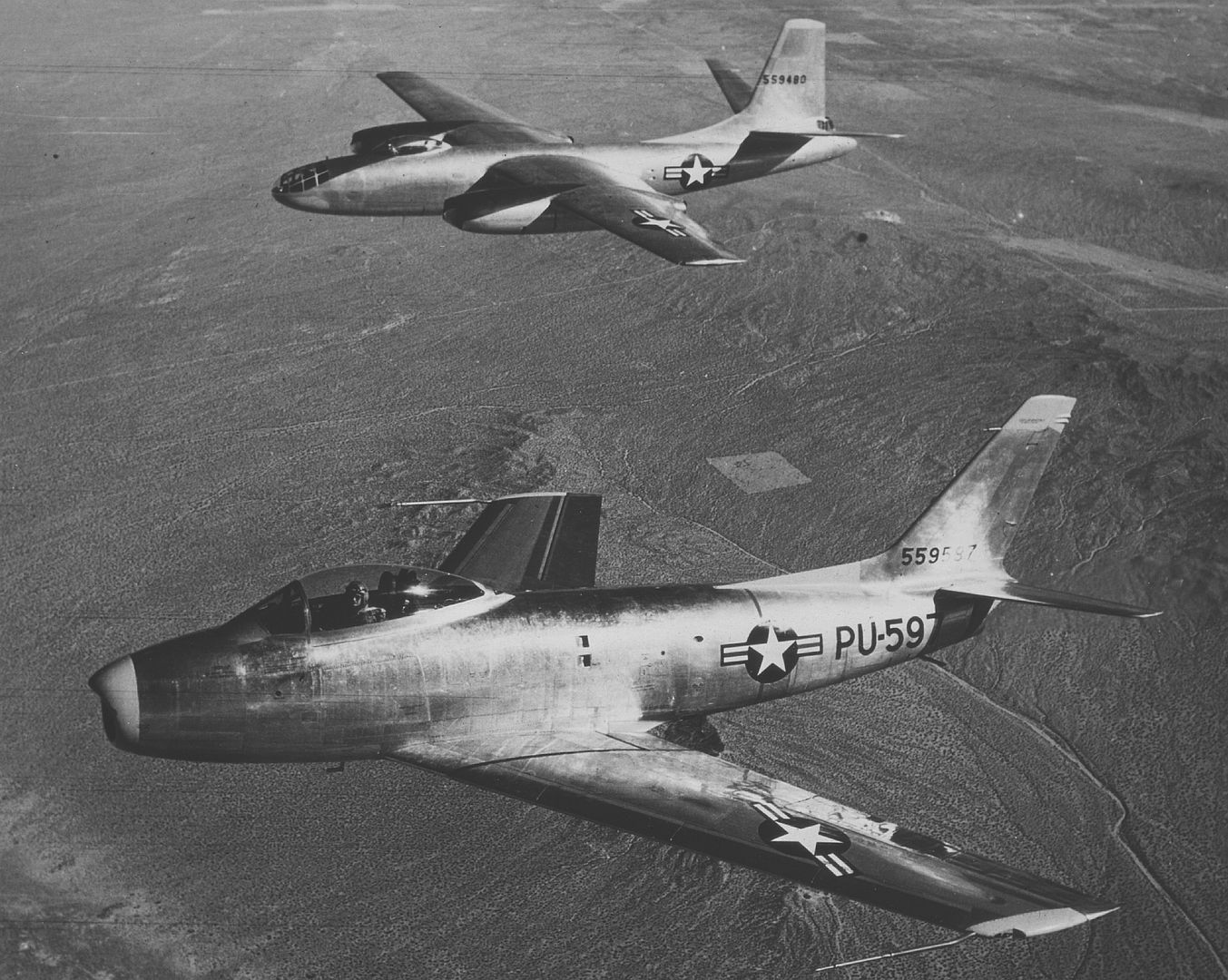

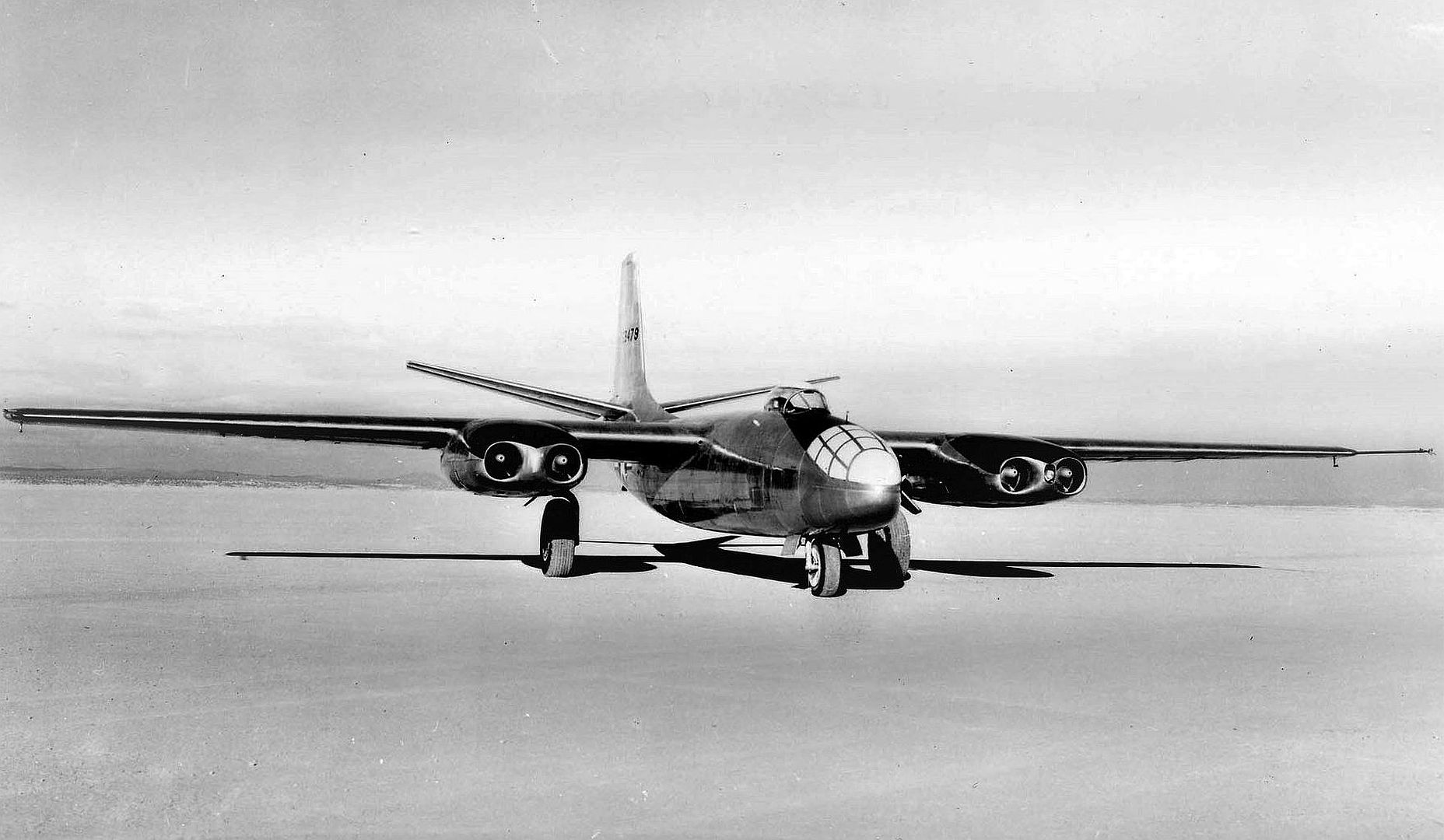
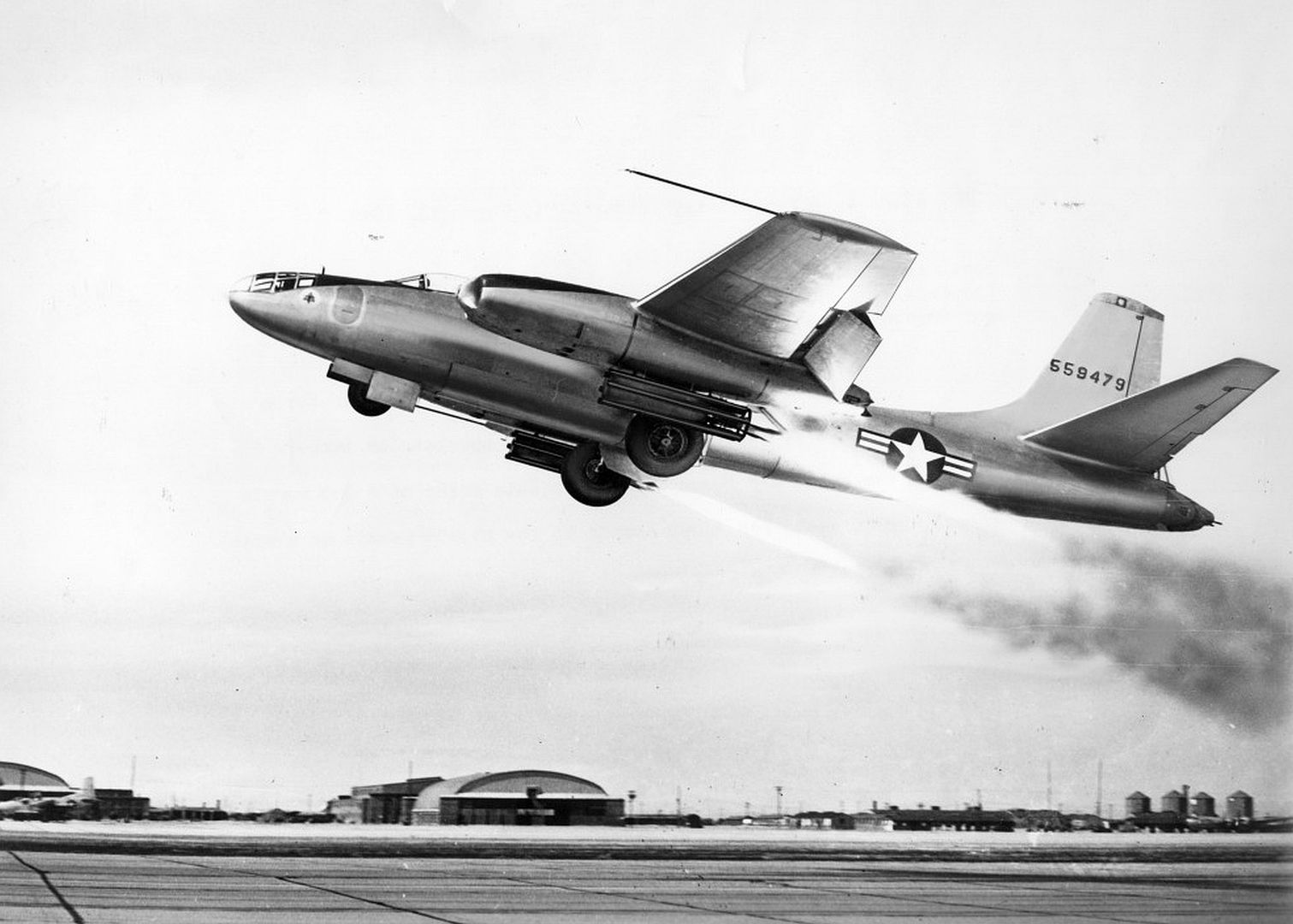
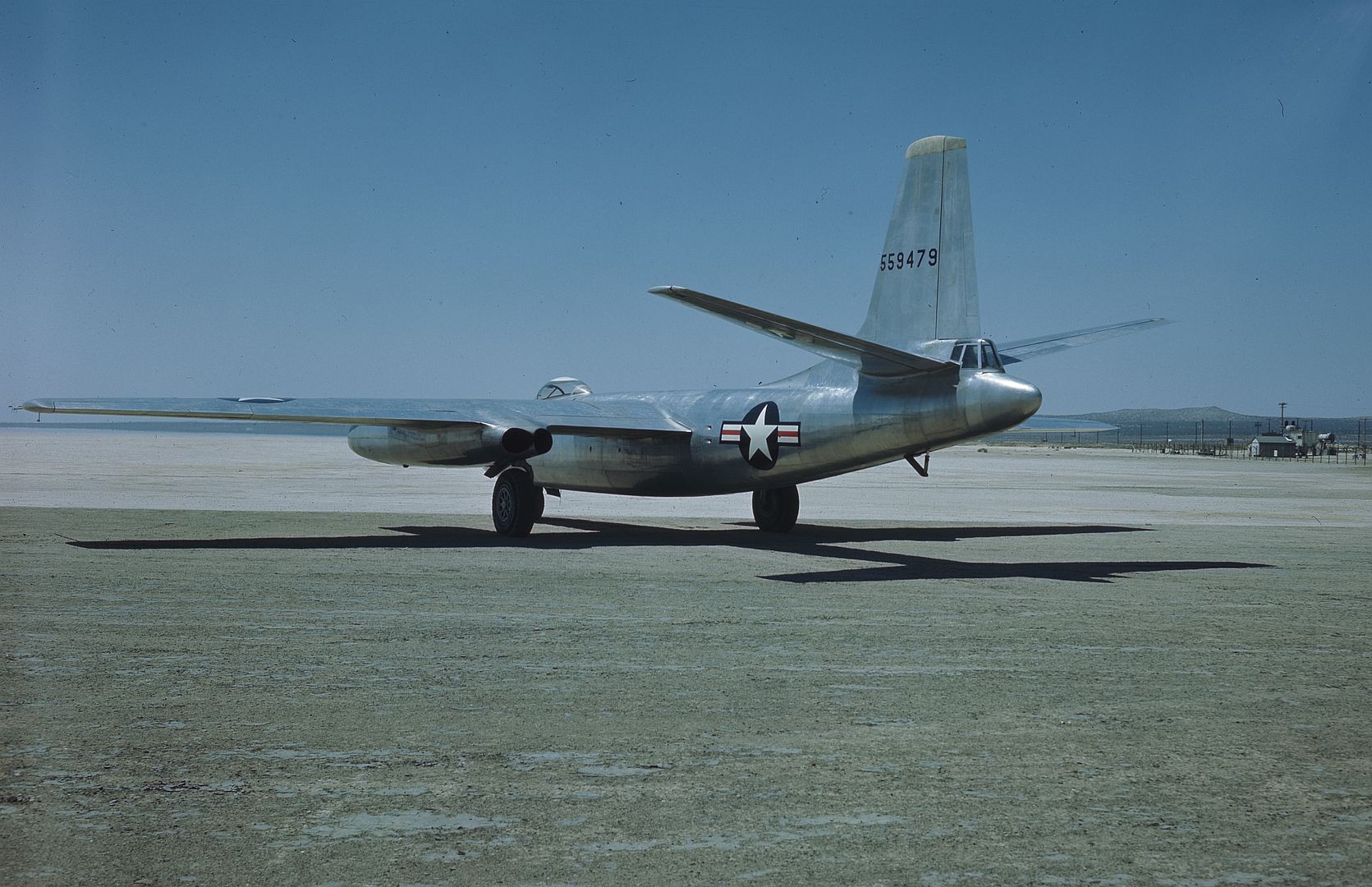

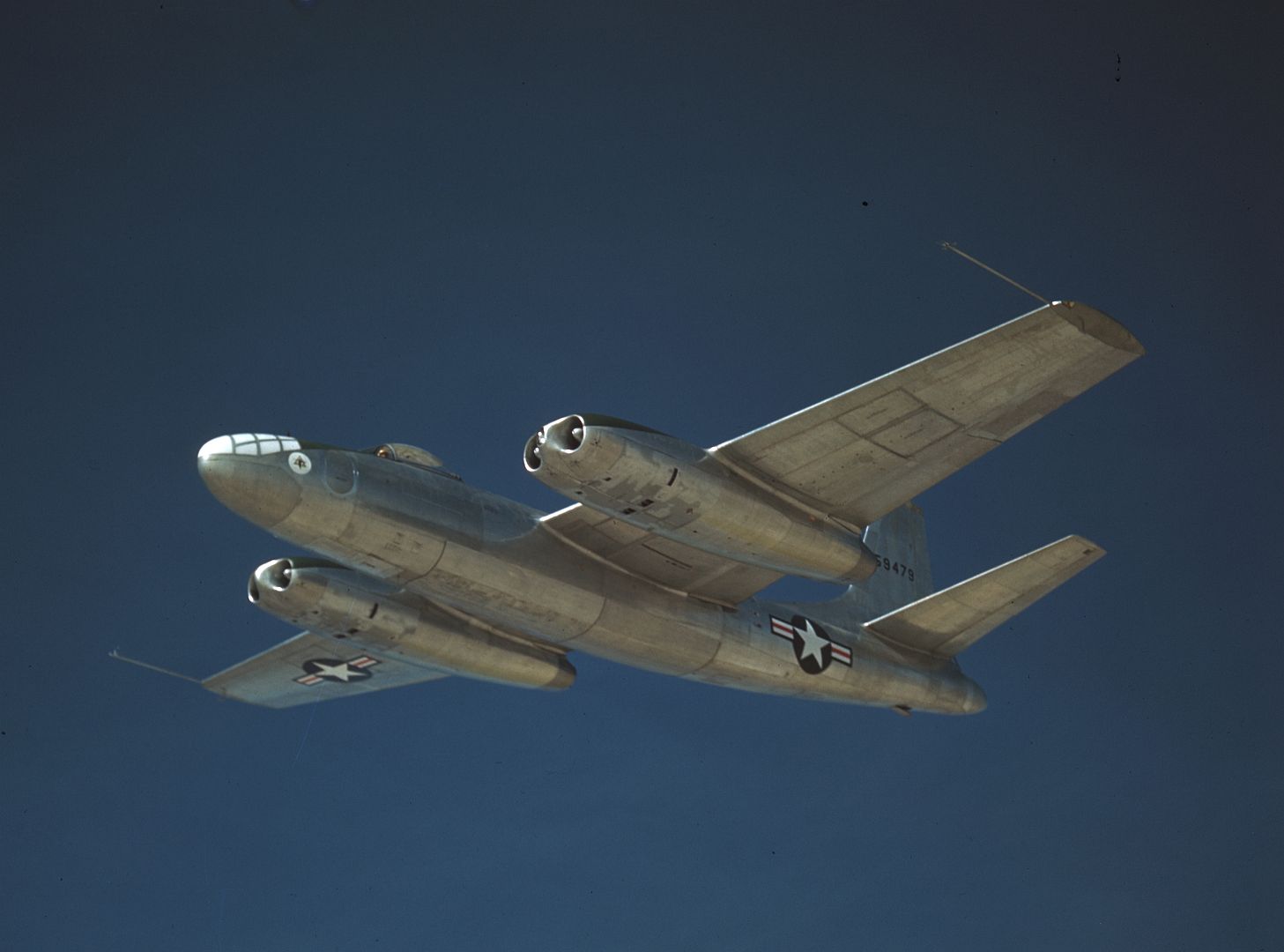
North American B-45A Tornado
The first production model of the Tornado was the B-45A (NA-147). It differed from the XB-45 in featuring improved ejection seats for the pilot and co-pilot and had safer emergency exits for the bombardier/navigator and the tail gunner. An E-4 automatic pilot was fitted. A bombing navigation radar and an A-1 fire control system were provided. Communication equipment, emergency flight controls, and copilot instrumentation were improved. Since the radar gun direction system originally planned for the Tornado was not yet perfected, a tail gunner's cockpit was provided for the aiming of the two 0.50-inch machine guns in the tail. A total of 1200 rounds of ammunition was provided for the tail guns.
Some of the B-45As were fitted with the AN/APQ-24 bombing/navigation radar system and were fitted with electronic countermeasures equipment such as the AN/APT-5.
The first production B-45A flew on February 24, 1948. The Air Force started taking delivery of the initial batch of 22 B-45A-1-NA aircraft in April of 1948. These were initially powered by four J35-A-11 engines, since the J47 engines were not yet ready.
The B-45A-1-NA was not considered as being combat-capable and most of them were assigned to training duties or to various test programs. Some of them became known as TB-45A-1-NA in recognition of their training role, but a few TB-45s were later brought up to combat configuration.
The next batch of Tornados, B-45A-5-NA, were equipped with more powerful J47 engines (either two J47-GE-7s or two J47-GE-13s, and two J47-GE-9s or two J47-GE-15s).
The first B-45As went into service in November 1948 with the 47th Bombardment Group based at Barksdale AFB in Louisiana. Despite slippages, 96 B-45As were completed by March of 1950
However, in the fiscal year 1949, there was a severe budgetary crunch which caused numerous defense appropriations to be severely cut back or cancelled outright. The B-45 was not to escape some of the cuts. According to original plans, five light bomb groups and 3 light tactical reconnaissance squadrons were to be equipped with Tornados. However, under the proposed fiscal 1950 budget, only one light bomb group and one light tactical reconnaissance squadron were to be equipped with Tornados. This meant that either the procurement of B-45s would have to be cut back or else substantial numbers of B-45s would have to placed in storage upon completion. Neither option was attractive, but the Aircraft and Weapons Board decided to cancel 51 of the 190 B-45 aircraft on order.
The early B-45As delivered to the USAF were not truly operational. They had no fire control bombing equipment, and they did not have suitable bombsights. Structural weaknesses such as cracked forgings had been noted in some aircraft, especially in those that had attempted violent low-altitude maneuvers. The new J47 engines had serious maintenance problems and had to be inspected after only 7 1/2 hours in the air and could be flown only 7 1/2 hours more before requiring a complete overhaul. There was insufficient money to purchase enough spare engines to ensure that the B-45s could be kept flying, and the F-86 Sabre had first priority for the J47.
The last of 96 B-45As was delivered to the Air Force in March of 1950.
The B-45 encountered severe operational difficulties. High speeds affected the gyrocompass adversely, and the E-4 automatic pilot frequently failed when the bomb doors were open. The emergency brake was unreliable. Bomb shackles would often become unhooked during certain maneuvers. Engines would often catch fire when first started because of an improper aspirator system. The airspeed indicator was often inaccurate, and the fuel pressure gauges were erratic. Those B-45s with the AN/APQ-24 bombing/navigation radar system had their own special problems. The AN/APQ-24 was a maintenance nightmare, and spare parts were in short supply. Malfunctions of the pressurization pump limited the altitude at which the system could operate. The radar antenna was not properly positioned, which limited the coverage of targets. In addition, the combat radius and the ferry range were too short.
Some of the late production B-45As were converted to B-45C configuration in an effort to extend their service life and to correct some of the problems encounted with the initial production version. These changes included the fitting of a stronger greenhouse-type segmented canopy, and the wingtips were modified so that they could carry 1200-gallon tanks that could be dropped in flight if necessary.
At one time, the Air Force had planned to transfer the 47th Group's B-45 Tornados to the Far East Air Force, based in Japan. However, the B-45 had insufficient range to reach Hawaii (the B-45A-1-NA had a ferry range of only 2120 miles) and the aircraft was too large to be loaded aboard Liberty or Victory ships without removing ten feet from each of the wings. Consequently, the deployment of the B-45A to the Far East was deemed impractical.
The outbreak of the Korean War in 1950 led to a decision to adapt the B-45 to the tactical nuclear role as a deterrent against a Soviet attack against western Europe. However, the B-45 had not originally been designed with the delivery of atomic bombs in mind. Because of the high degree of secrecy surrounding the nuclear bomb program, the North American engineers did not even know the dimensions of the early nuclear weapons, and it turned out that the B-45 bomb bay could not accommodate the first atomic bombs because of a large spar that extended across the width of the bomb bay. Expensive and time-consuming modifications would be needed to make the B-45 capable of carrying these bombs. The development of smaller and lighter atomic bombs in the later 1940s helped somewhat, but their development was also accompanied by excessive secrecy, and the B-45 could not carry these bombs either without extensive modifications.
In December 1950, the Air Staff decided to go ahead and direct AMC to modify B-45s for atomic duty. The program started with 9 aircraft--five of them would be equipped with the AN/APQ-24 system, and four with the AN/APN-3 Shoran navigation and bombing system plus the M9C Norden bombsight. Other B-45s were later added to the modification program. The bomb bay had to be structurally modified to handle three different types of atomic bombs, and a large amount of electronics support equipment had to be added. The aircraft had to be fitted with a new defensive system and extra fuel tanks. Modification work was done at the AMC Depot facility at San Bernardino, CA. The last aircraft was modified in April of 1952. The program was known as Backbreaker, and the planes were to go to the 47th Bombardment Wing based at RAF Sculthorpe in the United Kingdom.
The first nuclear-capable B-45As began to reach the United Kingdom in May of 1952, and by mid-June 40 aircraft were deployed. The tail defense system was upgraded, and the fuel flow totalizer (which had not been installed in the first 40 Backbreaker B-45s because of production delays) needed to be added. One specific type of atomic bomb required that the supports be moved into the forward bay to allow the installation of a 1200-gallon fuel tank in the rear bay. This program was not completed until March of 1954.
Four B-45A squadrons ended up serving in Europe during the early 1950s as the Strategic Air Command's first-line deterrent.
The B-45As rapidly became obsolescent as the B-47 Stratojet began to enter service. The B-45A began to be phased out of service beginning in the mid-1950s, and by January 1958, less than 50 were still operational. The B-45As with the 47th Bomb Wing (Tactical) rapidly converted to the Douglas B-66 Destroyer, and by July of 1958, the B-45s in the United Kingdom had all been transferred to other bases in Europe and North Africa. Most were junked there and sold for scrap.
Some of the early B-45As powered by Allison engines were used for training purposes under the designation TB-45A. Some of them were used as target tugs with a hydraulically-controlled reel and cable system in the bomb bay for a 20-foot Chance Vought target glider. A few of them were later brought up to the Backbreaker configuration.
The DB-45A was a conversion that was used as a director in guided weapons development.
The last production B-45A (47-096) was modified for use as an inflight engine testbed and was redesignated JB-45A. The test engine was attached to a retractable pylon mounted inside the modified bomb bay. Once airborne, the test engine was lowered into the slipstream and was started.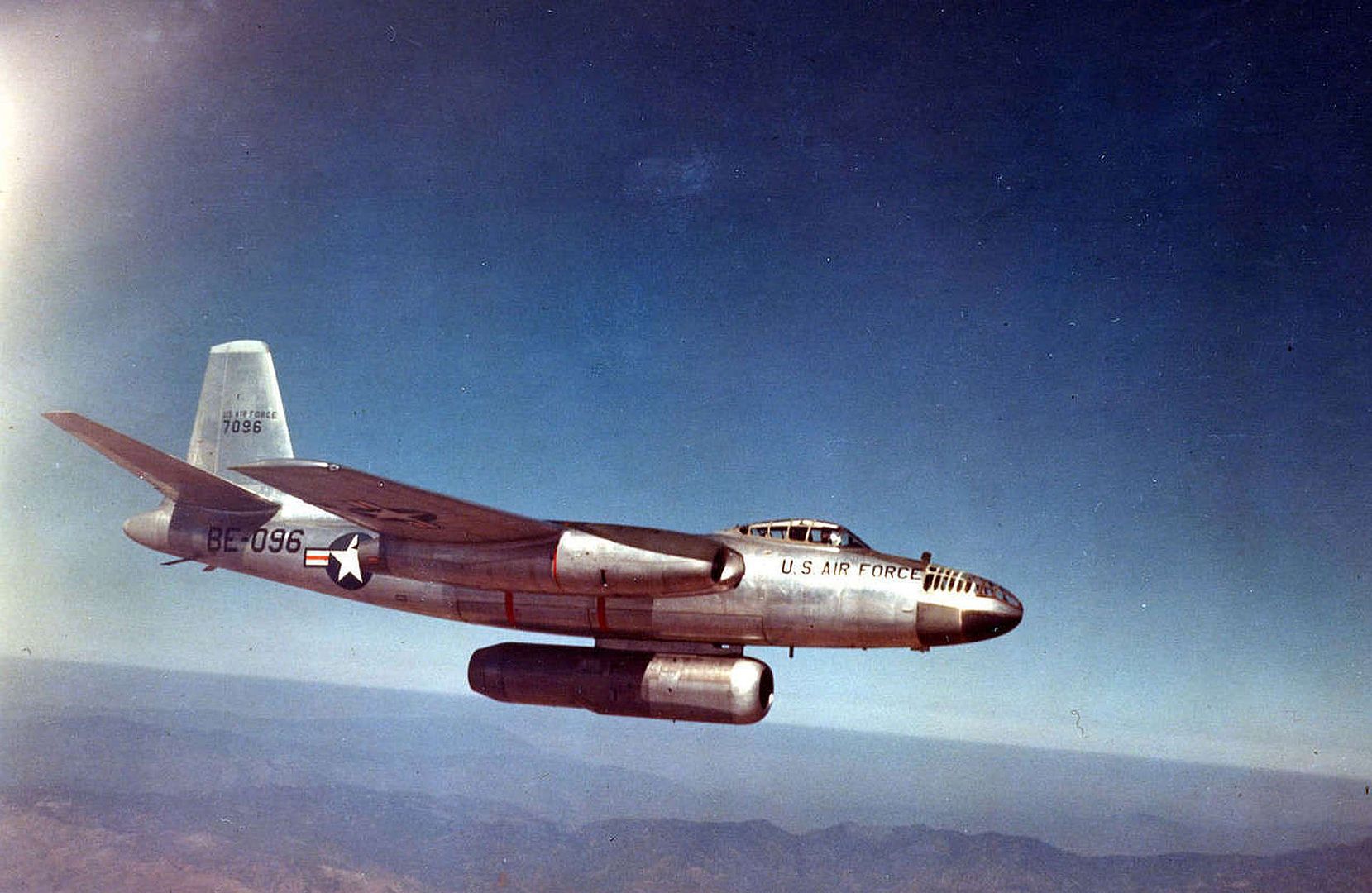
A Tornado marked as B-45A 47-008 is on display at the Castle AFB museum in California. However, it has the reinforced canopy of the later B-45C. The canopy was changed either during its service as a Navy drone controller or when the aircraft was brought from China Lake Naval Weapons Center to Castle for restoration. It was brought in pieces and reassembled at Castle.
Serials of B-45A:
47-001/022 North American B-45A-1-NA Tornado
008 on display at Castle AFB Museum
47-023/096 North American B-45A-5-NA Tornado
47-097 Static test airframe for B-45A Tornado
Specification of North American B-45A Tornado:
Engines: Four General Electric J47-GE-13/15 each rated at 5200 lb.st. Alternatively, four J47-GE-7/9 engines were provided. Performance: Maximum speed 571 mph at 3500 feet, 503 mph at 37,000 feet. Cruising speed 470 mph at 35,000 feet. Stalling speed 125 mph. Initial climb rate 5950 feet per minute. Combat ceiling 42,800 feet. Service ceiling 46,400 feet. Combat radius 533 miles with 10,000 pound bombload. Takeoff ground run 3400 feet. Takeoff over 50 foot obstacle 4930 feet. Dimensions: Wingspan 89 feet 0 inches, length 75 feet 4 inches, height 25 feet 2 inches, wing area 1175 square feet. Weights: 45,694 pounds empty, 81,418 pounds gross. Armament: two 0.50-inch M-3 machine guns in tail turret. Maximum bomb load 22,000 pounds. Could carry 27 500-lb bombs in two bays for a distance of 800 miles or a single 22,000-lb Grand Slam bomb, or two 4000-lb nuclear bombs.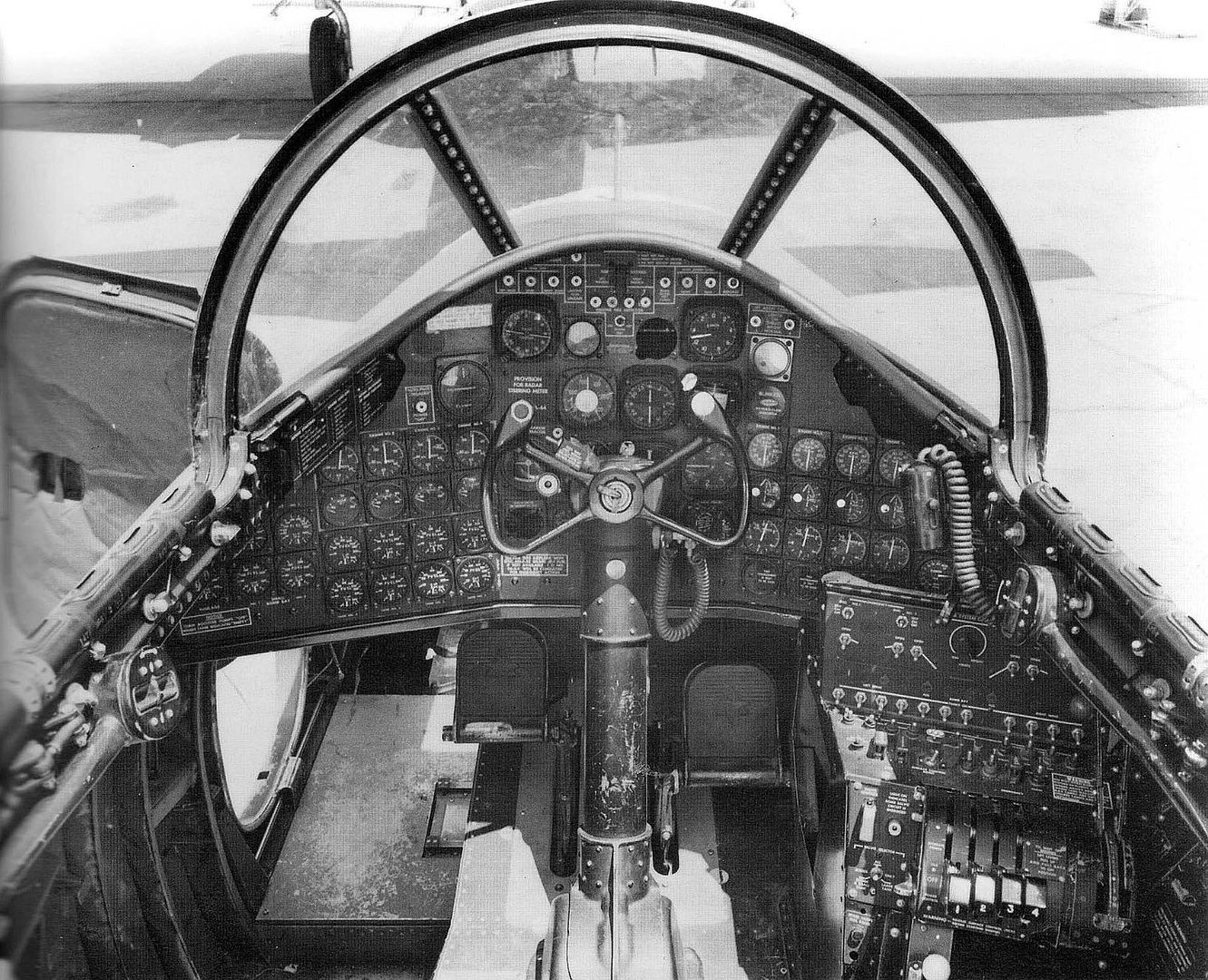
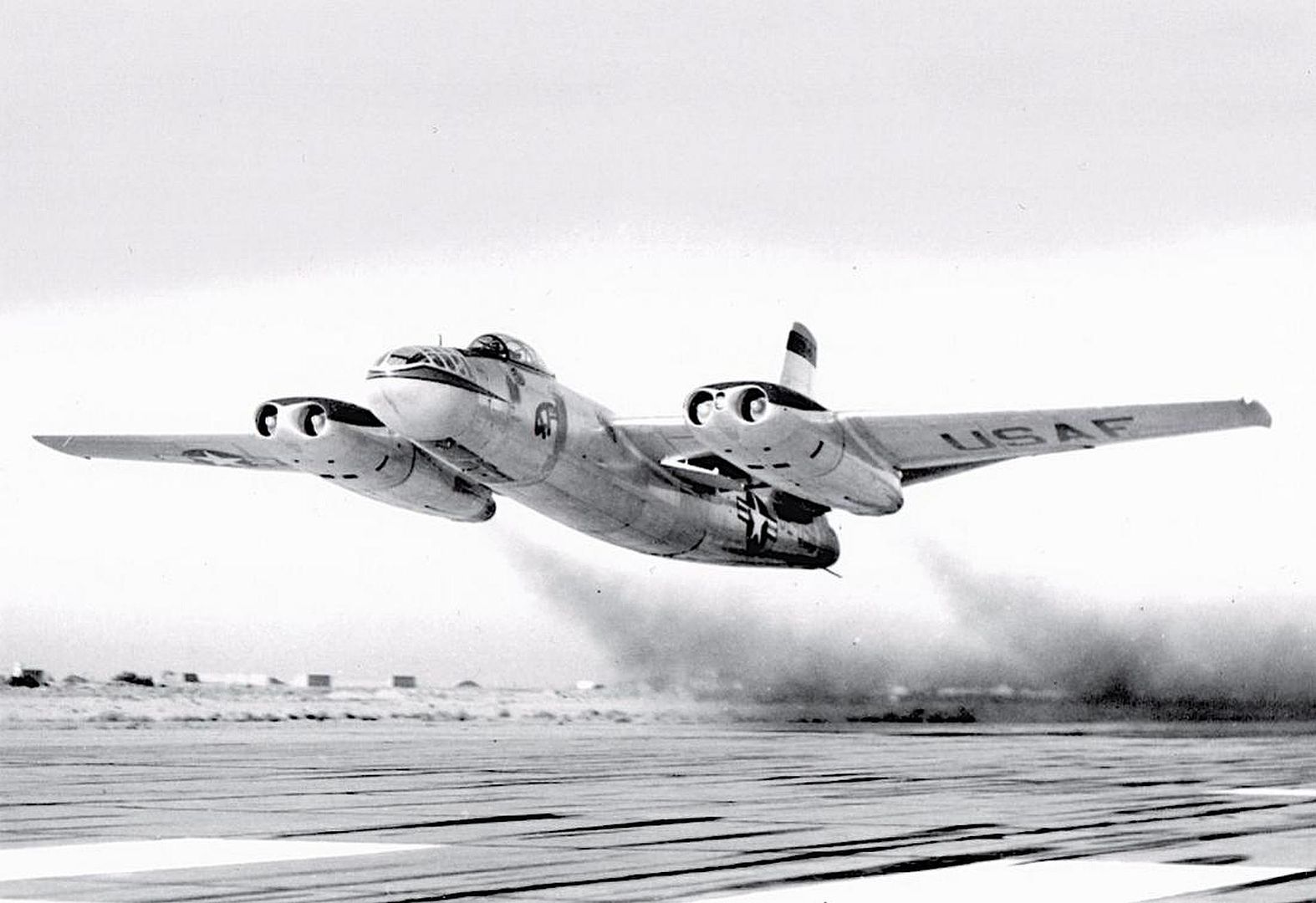
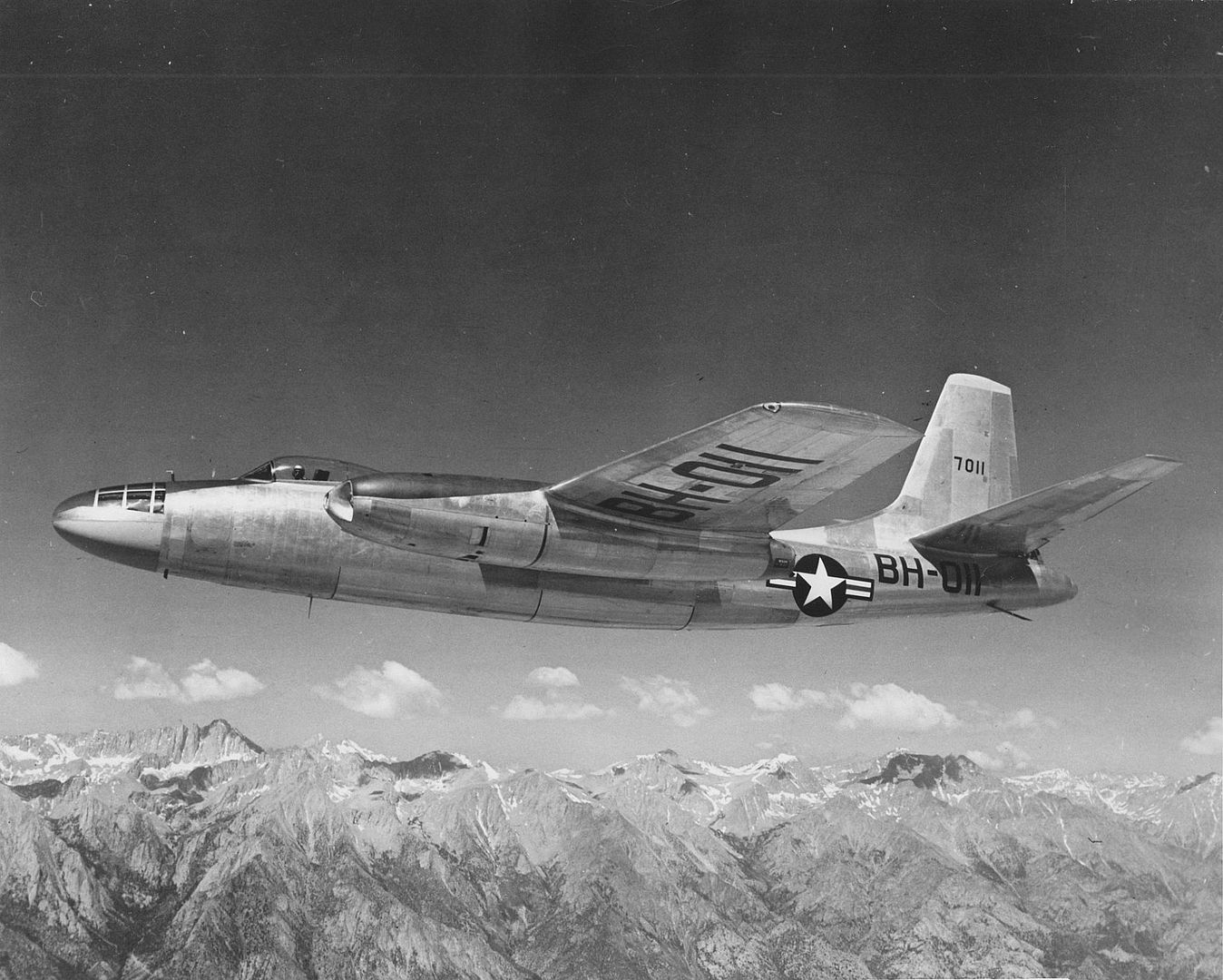

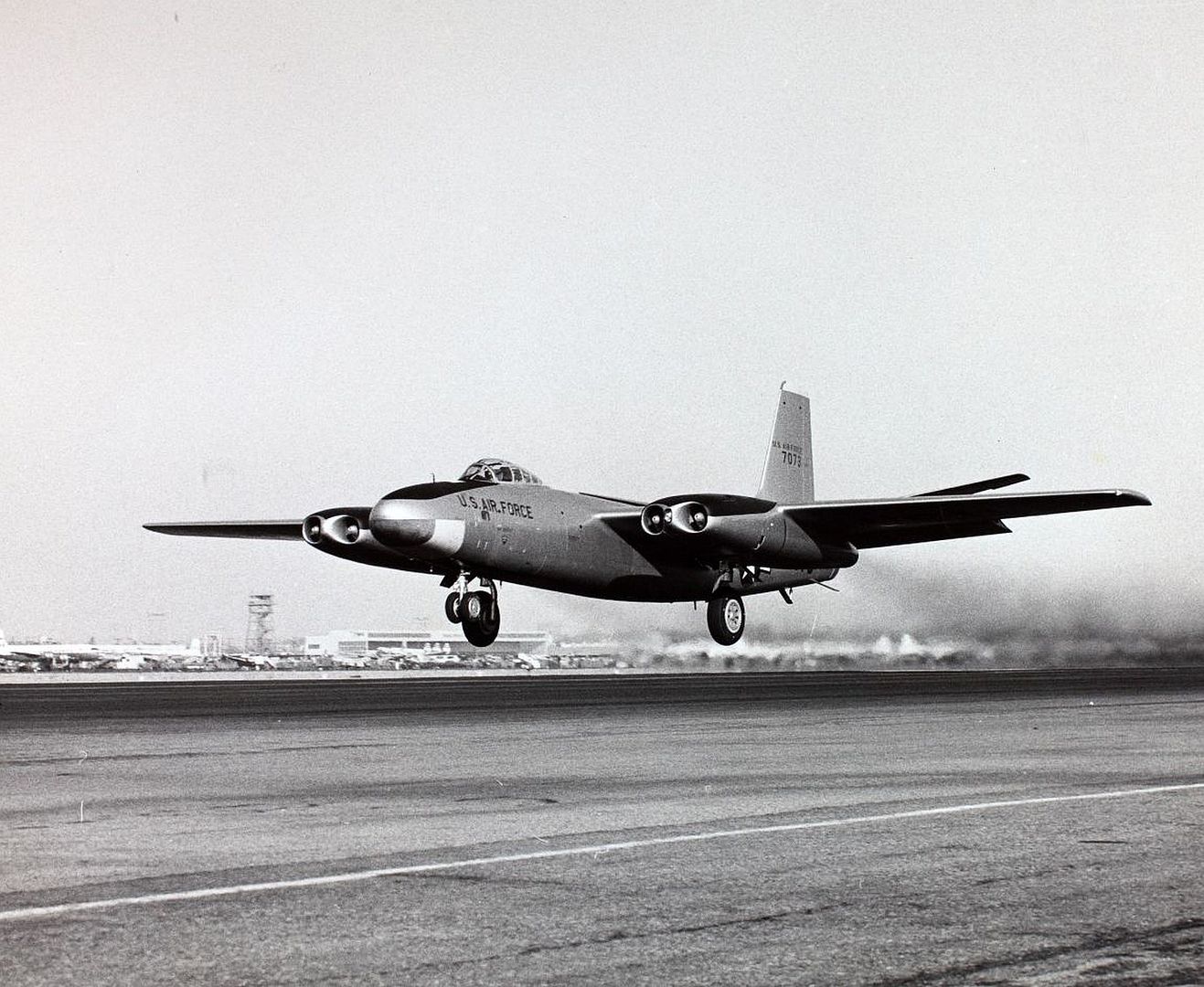
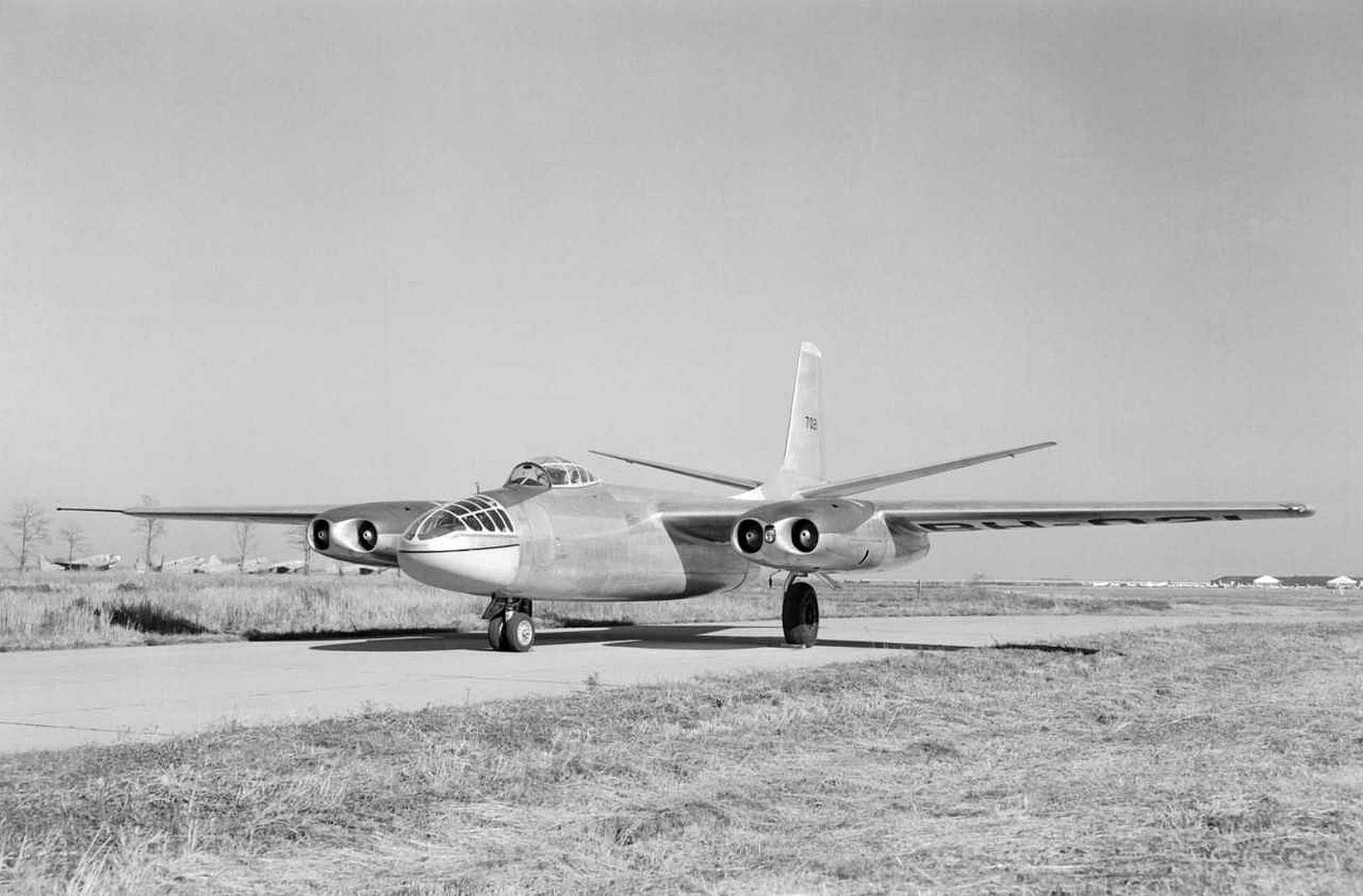

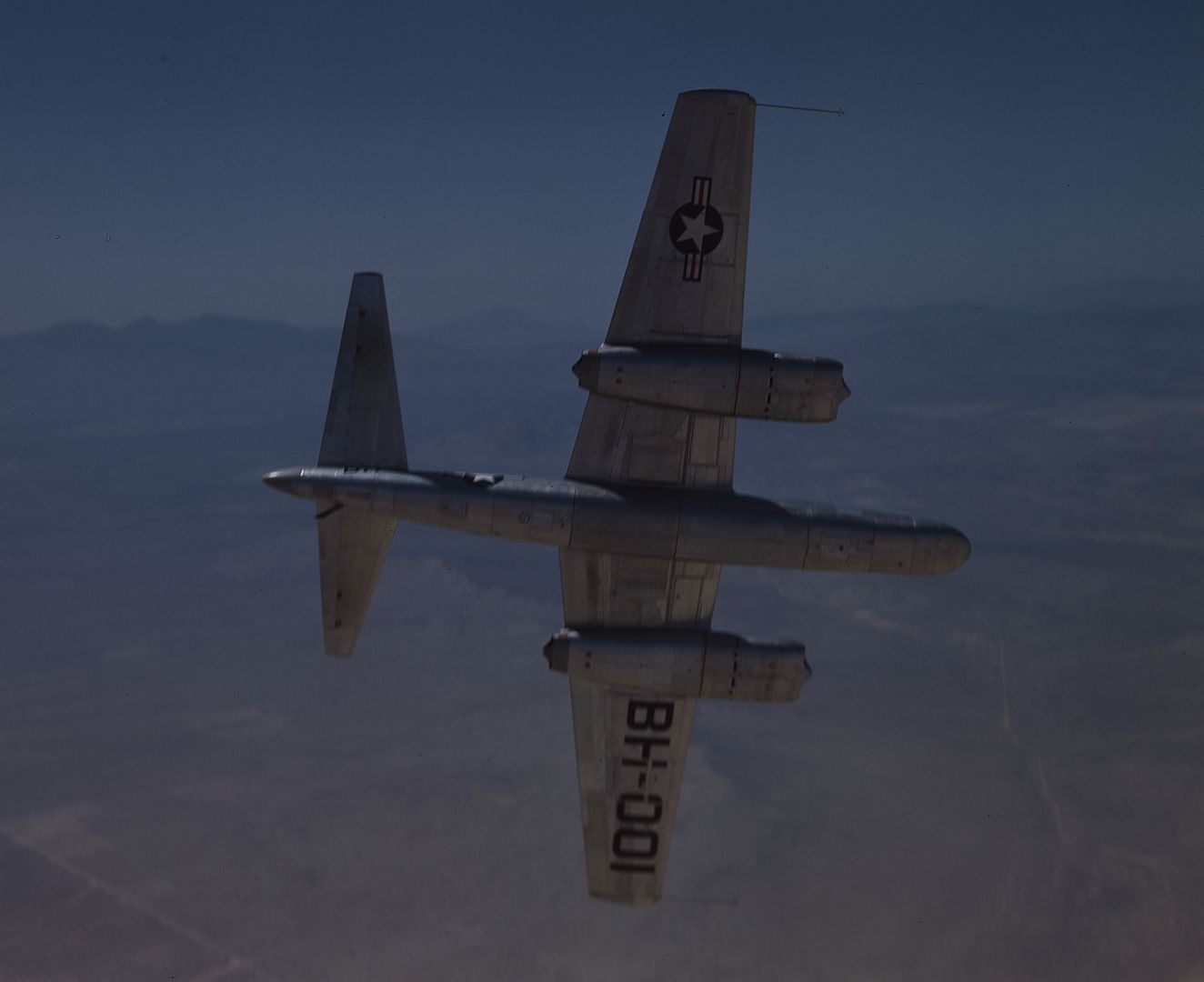
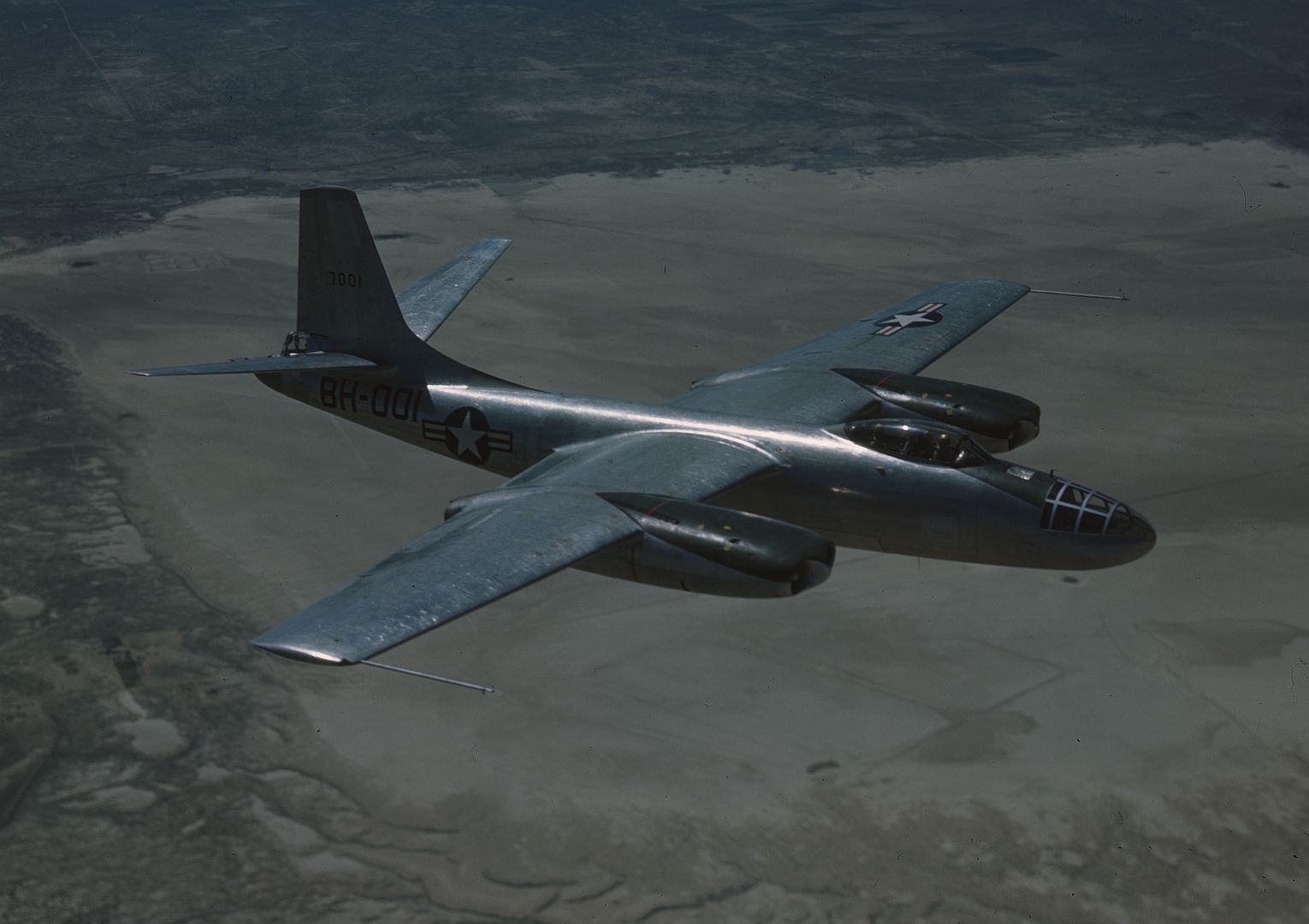

North American B-45B Tornado
The B-45A has a convention tail gunner position because the radar-directed defensive fire control system that was originally planned was not yet available. The B-45B was a proposed variant of the B-45A that would offer new radar and fire-control systems. The B-45B never reached production. -
2 years agoSun Feb 26 2023, 01:56pmDuggy
 Main AdminNorth American B-45C Tornado
Main AdminNorth American B-45C Tornado
The next production version of the Tornado was the B-45C (NA-153). The B-45C differed from the B-45A in having a pair of 1200-US gallon wing tip fuel tanks which could be dropped in flight if necessary. It also featured a strengthened cockpit canopy with numerous reinforcements which replaced the completely transparent bubble canopy fitted to the earlier B-45A. The B-45C was equipped for mid-air refuelling via a boom receptacle located on the top of the fuselage. A single point ground refueling receptacle was located on the left hand side of the bomb bays. The B-45C had four 5200 lb.s.t. J47-GE-13/15 engines, and had gross weight increased from 90,000 pounds to 110,000 pounds.
Work on the B-45C began on September 22, 1947, The first B-45C flew for the first time on May 3, 1949. Production of the B-45C was completed on April 13, 1950.
The Air Force had originally planned to buy a sizeable fleet of B-45Cs, but after only ten examples were completed, the decision was made to stop production and switch over to large-scale manufacture of the new swept-winged Boeing B-47 Stratojet. 33 B-45C aircraft that were still on the production line were modified as photo-mapping and reconnaissance planes and delivered under the designation RB-45C.
The DB-45C was a B-45C conversion that was used as a director for guided weapon development.
One B-45C (48-009) was modified as an engine test bed for Pratt & Whitney J57 and J75 jet engines under the designation JB-45C. Like the JB-45A, the aircraft had the test engine attached to a pylon mounted in the bomb bay. While on the ground, the test engine was partially retracted into the bomb bay because of limited landing gear ground clearances. When in flight, the test engine was lowered into the slipstream and started.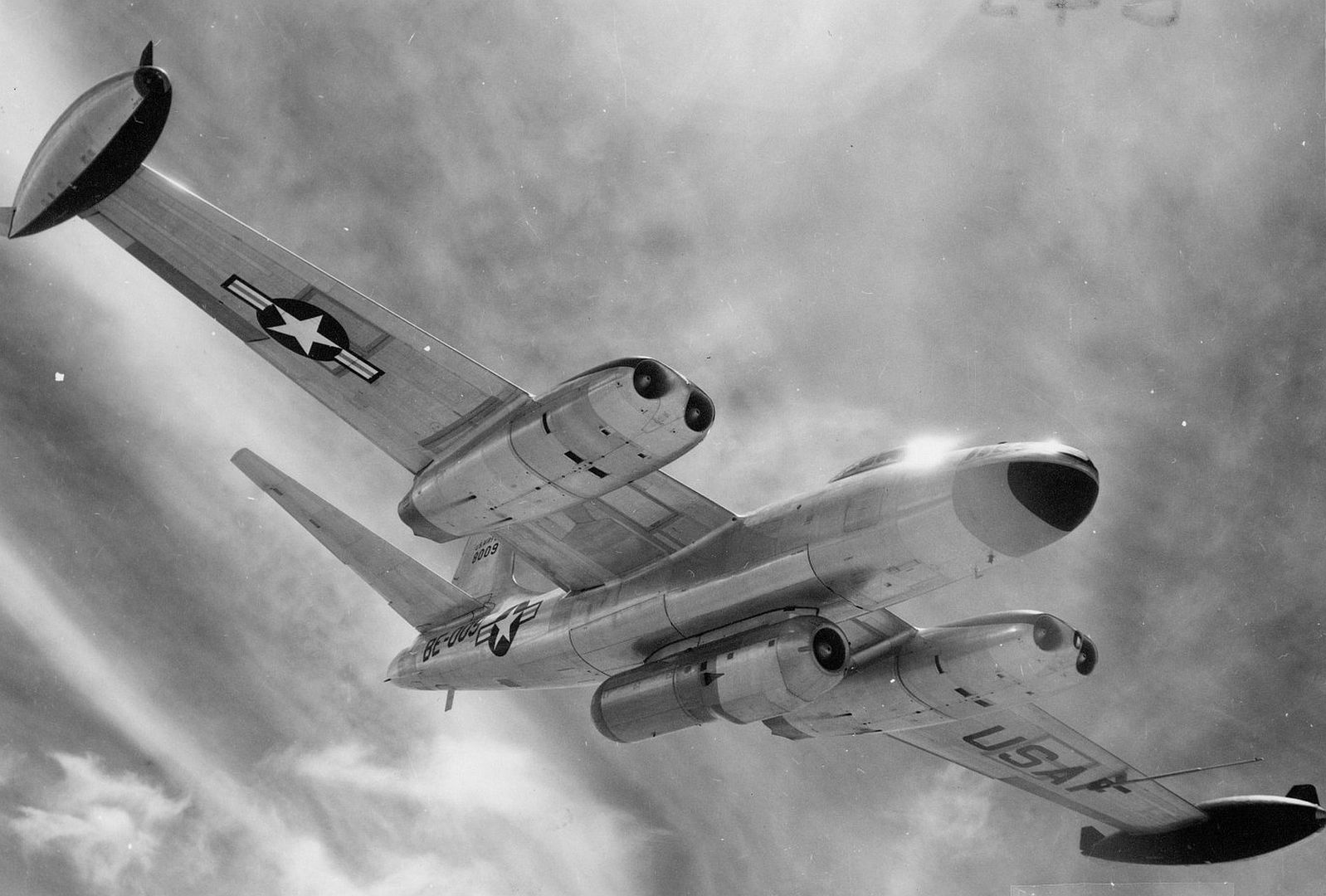
B-45C 48-010 is on display at the USAF Museum at Wright Patterson AFB in Ohio.
Serials of B-45C:
48-001/010 North American B-45C Tornado
009 converted to JB-45C
010 is on display at WPAFB Museum
Specification of North American B-45C Tornado:
Engines: Four General Electric J47-GE-13/15 each rated at 5200 lb.s.t. and 6000 lb.s.t with water injection. Crew: Four (pilot, copilot-radio operator, bombardier-navigator, tail gunner) Performance: Maximum speed 579 mph at sea level, 509 mph at 32,500 feet. Cruising speed 456 mph. Stalling speed 153 mph. Initial climb rate 5800 feet per minute. Service ceiling 43,200 feet. Combat radius 1008 miles with 10,000 pounds of bombs. Ferry range 2426 miles. Dimensions: Wingspan 89 feet 0 inches (without wingtip tanks), length 75 feet 4 inches, height 25 feet 2 inches, wing area 1175 square feet. Weights: 48,903 pounds empty, 112,952 pounds gross. Armament: two 0.50-inch M-7 machine guns in tail turret. A maximum bombload of 22,000 pounds could be carried.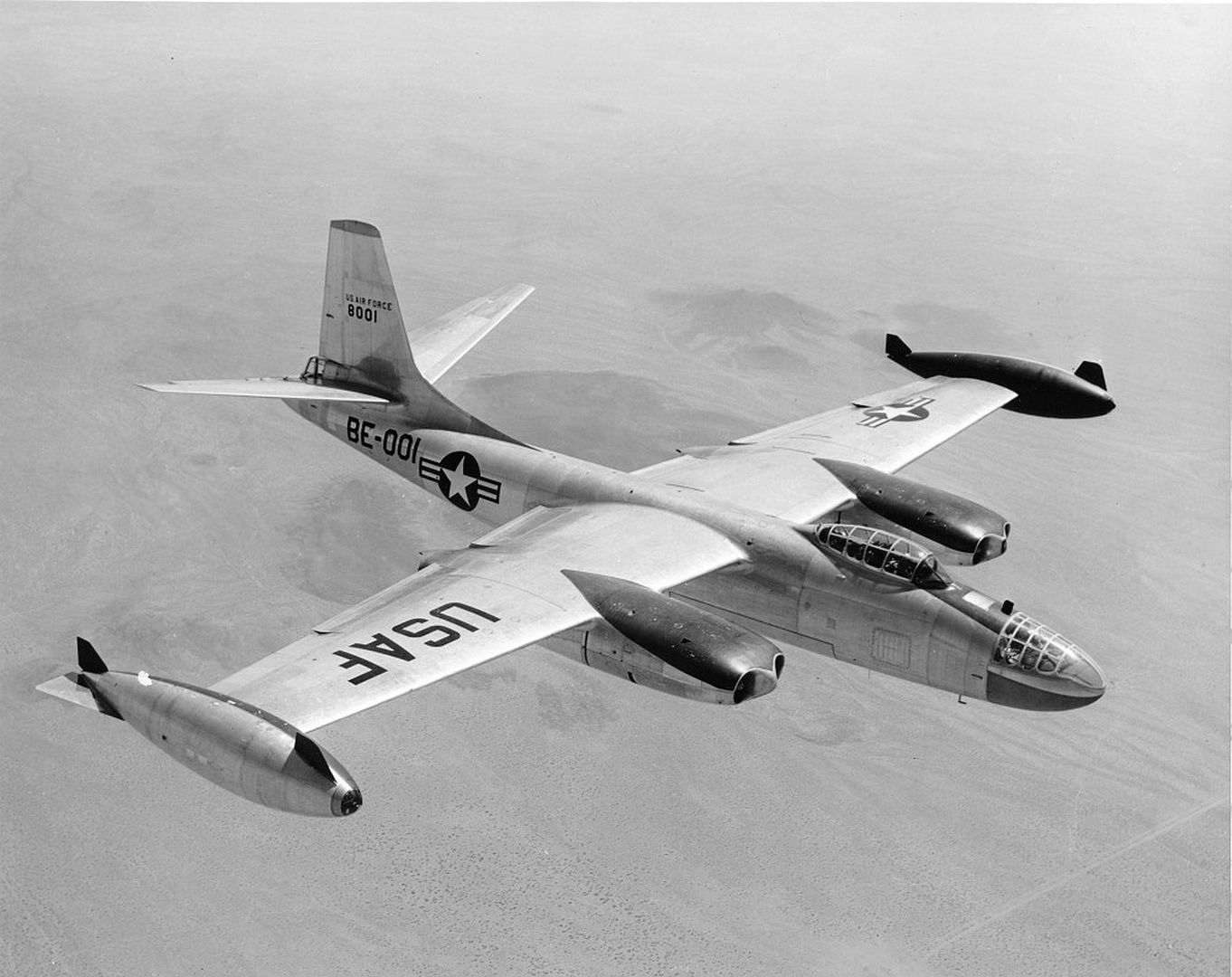
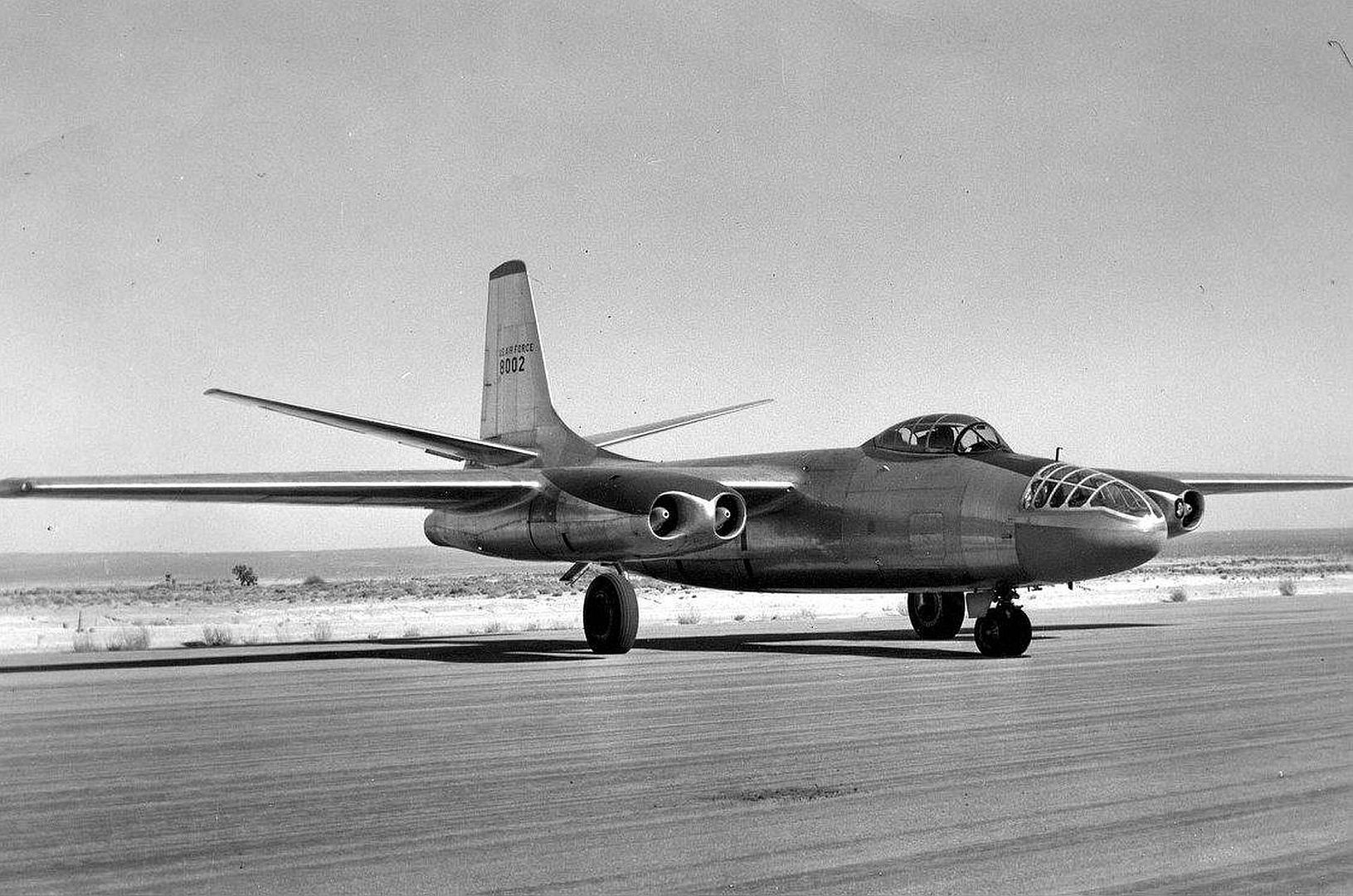
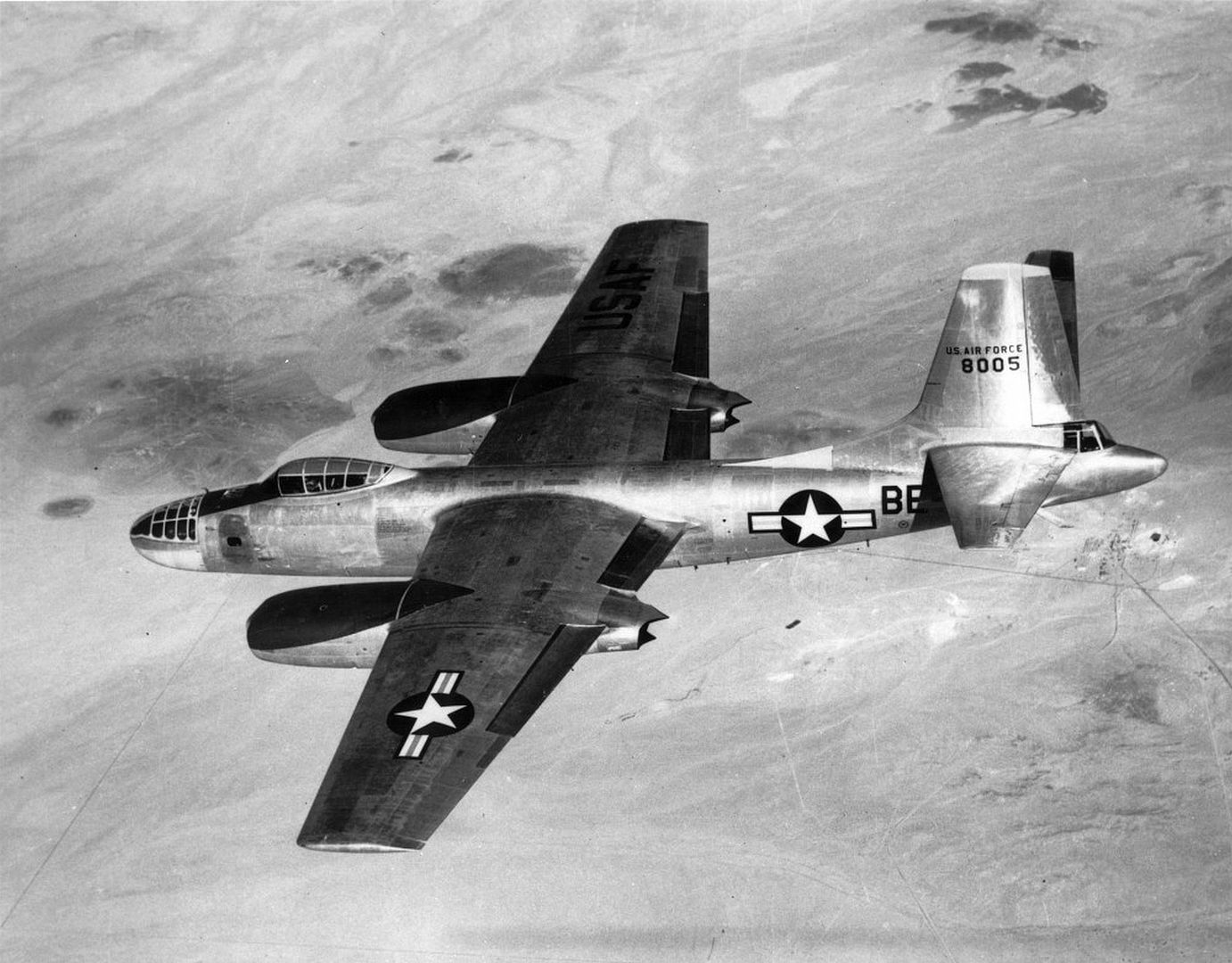

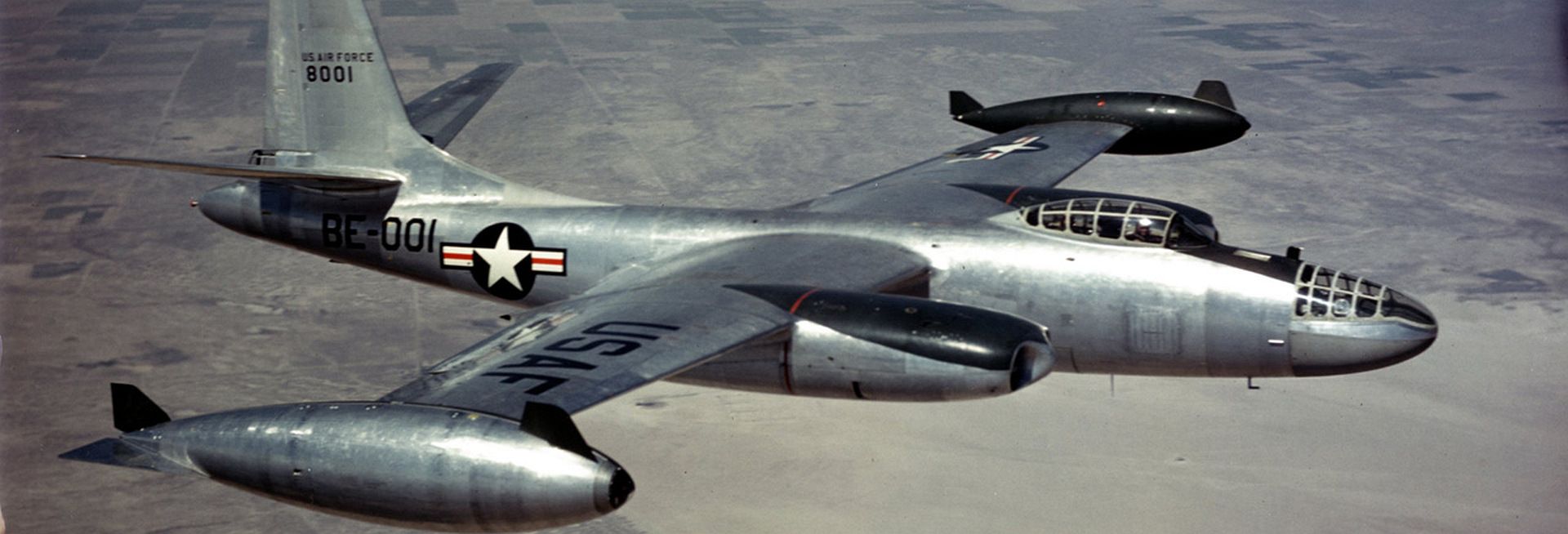
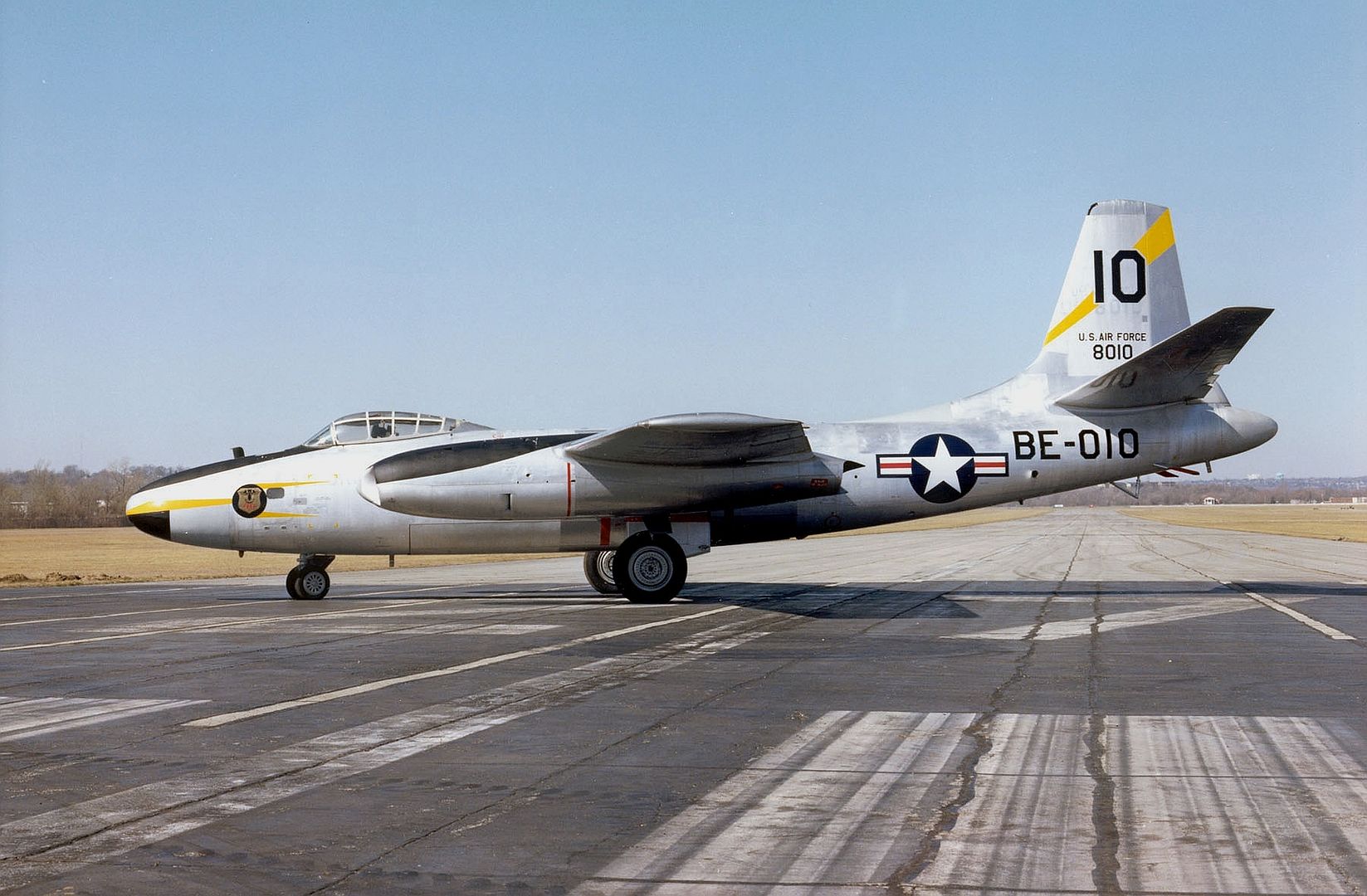
North American RB-45C Tornado
The last production version of the Tornado was the RB-45C. The RB-45C (NA-153) was a reconnaissance version of the B-45C. The transparent bombardier's nose was completely faired over, and the tip of the aircraft's nose where a forward oblique camera was installed had a characteristic duck's bill shape. The RB-45C had a water injection system for increased takeoff thrust that used two 214-gallon droppable tanks suspended underneath the nacelles. In place of these water tanks, the RB-45C could also carry two droppable JATO rockets.
The crew was normally four--pilot, co-pilot/radio operator, tail gunner, and photo-navigator. The pilot and copilot sat in tandem underneath the transparent canopy, the photo navigator sat inside the nose, and the tail gunner occupied a position behind the vertical tail.
The RB-45C was also equipped with inflight refuelling capability, with the refueling receptacle being installed immediately aft of the cockpit canopy.
A total of 12 cameras could be carried in four positions--four at the vertical position in the rear fuselage, four at the split vertical station, one tri-metrogen K-17C mounted on a pallet just aft of the wing trailing edge, and one forward oblique camera in the nose. The forward oblique camera nose installation gave a characteristic duck's bill appearance to what had been the bombardier's glazed nose. The bomb-bay was retained, but on photo missions it carried only 25 M-122 photoflash bombs together with additional fuel tanks. The total fuel capacity of the aircraft was 8133 US gallons.
The crew could move to the aft camera compartment while in flight. However, access to the bomb bays was possible in flight only if the bomb bays were empty, the bomb bay doors were closed, and the pressurized compartments were depressurized.
The first RB-45C flew in April of 1950. The first RB-45C was delivered to the Air Force in June of 1950 Most of the RB-45Cs were delivered to SAC. The last of 33 RB-45Cs was delivered in October 1951.
The RB-45C served with the 95st Strategic Reconnaissance Squadron and saw some action in Korea. The first TAC RB-45s arrived in the Far East in the autumn of 1950. By this time, the RB-29s of the 91st Strategic Reconnaissance Squadron were now being confronted with Chinese-piloted MiG-15s and were no longer able to perform reconnaissance, targeting, and bomb-damage assessment photography with impunity. The RB-45C unit was attached to the 91st Squadron and began flying reconnaissance missions over northwestern Korea. The RB-45Cs were able to evade the MiGs for several months, but on April 9, 1951 one of the RB-45Cs had a close call and was barely able to escape a numerically superior enemy. At that time, it was decided that RB-45s could no longer go into northwestern Korea without fighter escort. Another close call on November 9, 1951 caused the RB-45s to be restricted from entering northwestern Korean airspace in daylight even when fighter escort was available. In January of 1952, the 91st Squadron was ordered to convert to night operations. Some RB-45Cs were painted all black so that they would not show up on enemy searchlights. However, the RB-45s were not well suited for night photography because the aircraft buffeted too badly when the forward bomb bay doors were opened to drop flash bombs. The RB-45s were withdrawn from the Korean theatre early in 1952, bringing the Korean experience with the RB-45 to an end.
Early-model RB-45Cs carried tail gunners with fully operational twin 0.50 machine guns, but the gunner was sometimes deleted and the guns were fixed in place to fire either upward at a 45-degree angle or downward at a 45-degree angle, operated by the pilot through a toggle switch. Once adjusted on the ground, the guns could not be moved in flight.
The RB-45C also served with the 19th Tactical Reconnaissance Squadron in Europe. Never officially disclosed until recent top secret documents were declassified and released by the National Archives was the fact that the Royal Air Force was also equipped with the RB-45C. The RAF crews were trained at Sculthorpe in the UK and at bases in the United States. Their mission was to conduct deep penetration and reconnaissance flights over the Soviet Union during the mid-1950s.
Operation Ju-jitsu From Wikki.
The only other nation to use the RB-45C was the United Kingdom, where it was operated by an ad hoc unit of crews largely drawn from Nos. 35 and 115 squadrons. Whilst the USAF was prohibited by the President of the United States from overflying the Soviet Union at the time, US allies closer to the European theatre of war could. In the United Kingdom, whilst successive Labour governments had refused, the return of Winston Churchill and a Conservative administration to Downing Street brought a more co-operative atmosphere to joint intelligence initiatives.
As a result, under Operation Ju-jitsu, in July 1951 four aircraft were leased to Britain from the 91st Strategic Reconnaissance Wing to form 'Special Duties Flight, Sculthorpe', commanded by Squadron Leader John Crampton. Stripped of USAF markings and then applied with RAF markings, the four aircraft were attached to a USAF squadron based at RAF Sculthorpe, Norfolk in eastern England. The aircraft were tasked with flying deep-level reconnaissance missions over the Soviet Union to gather electronic and photographic intelligence. The Special Duties Flight conducted missions during the period 1952–54.
On April 17, 1952, three aircraft were assigned to head for Kyiv from Germany, scheduled to return to Sculthorpe ten hours later. Flying at 36,000 feet (11,000 m), Crampton's aircraft was tracked by ground radar and came under antiaircraft fire. Applying full power, he immediately turned and headed for Germany, none too soon, as Soviet night fighters had been dispatched to hunt down his aircraft.
Subsequent flights over Ukraine were carried out using English Electric Canberras under the codename Project Robin, operating at higher altitudes of around 54,000 ft (16,000 m). It was not until 1994 (under the "fifty-year rule" of the Public Records Act 1958) that the existence of the spy missions became public knowledge.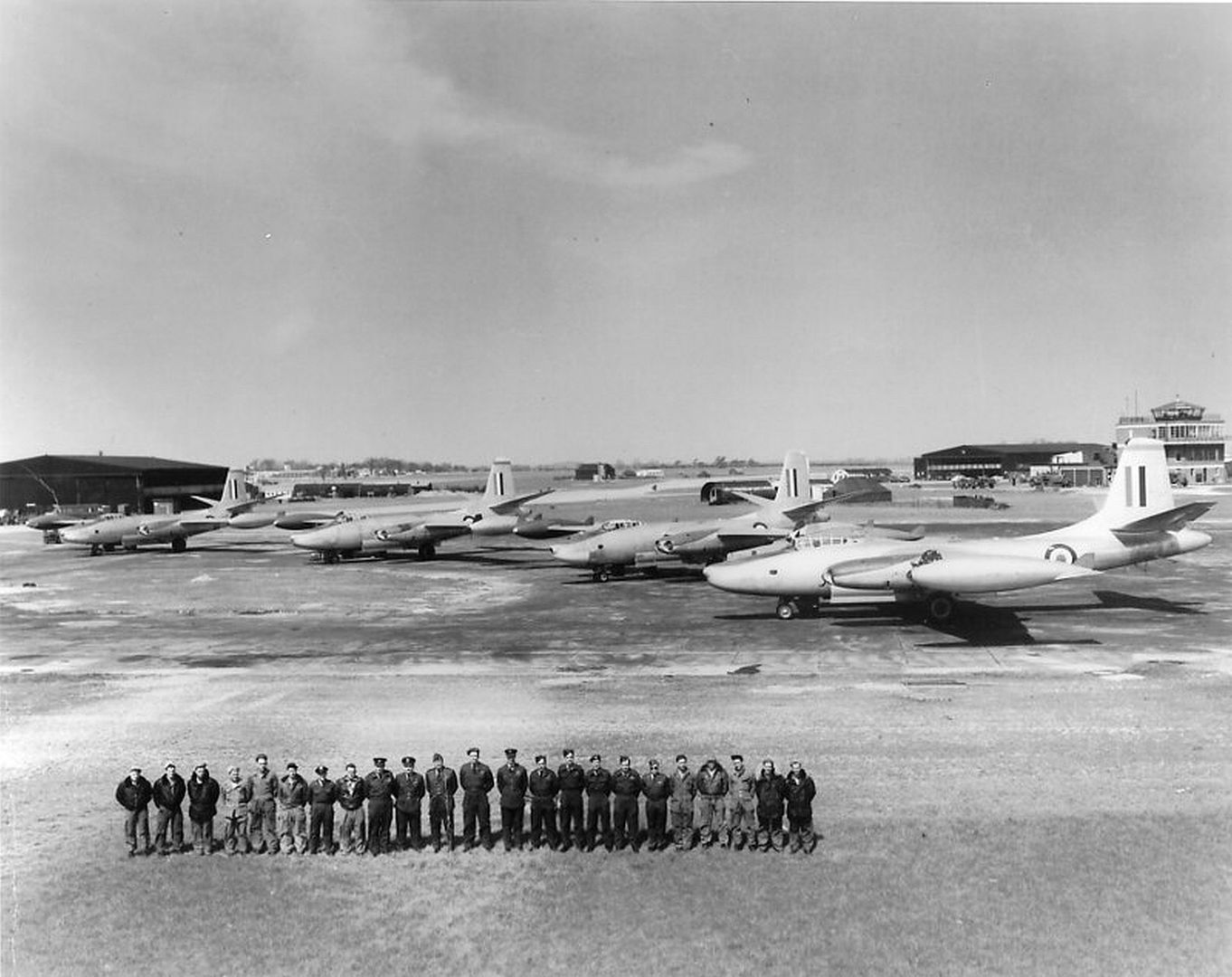
In 1950, a SAC RB-45C (48-012) carried out the first air-to-air refueling of a jet aircraft, the tanker aircraft being a boom-refueling KB-29P.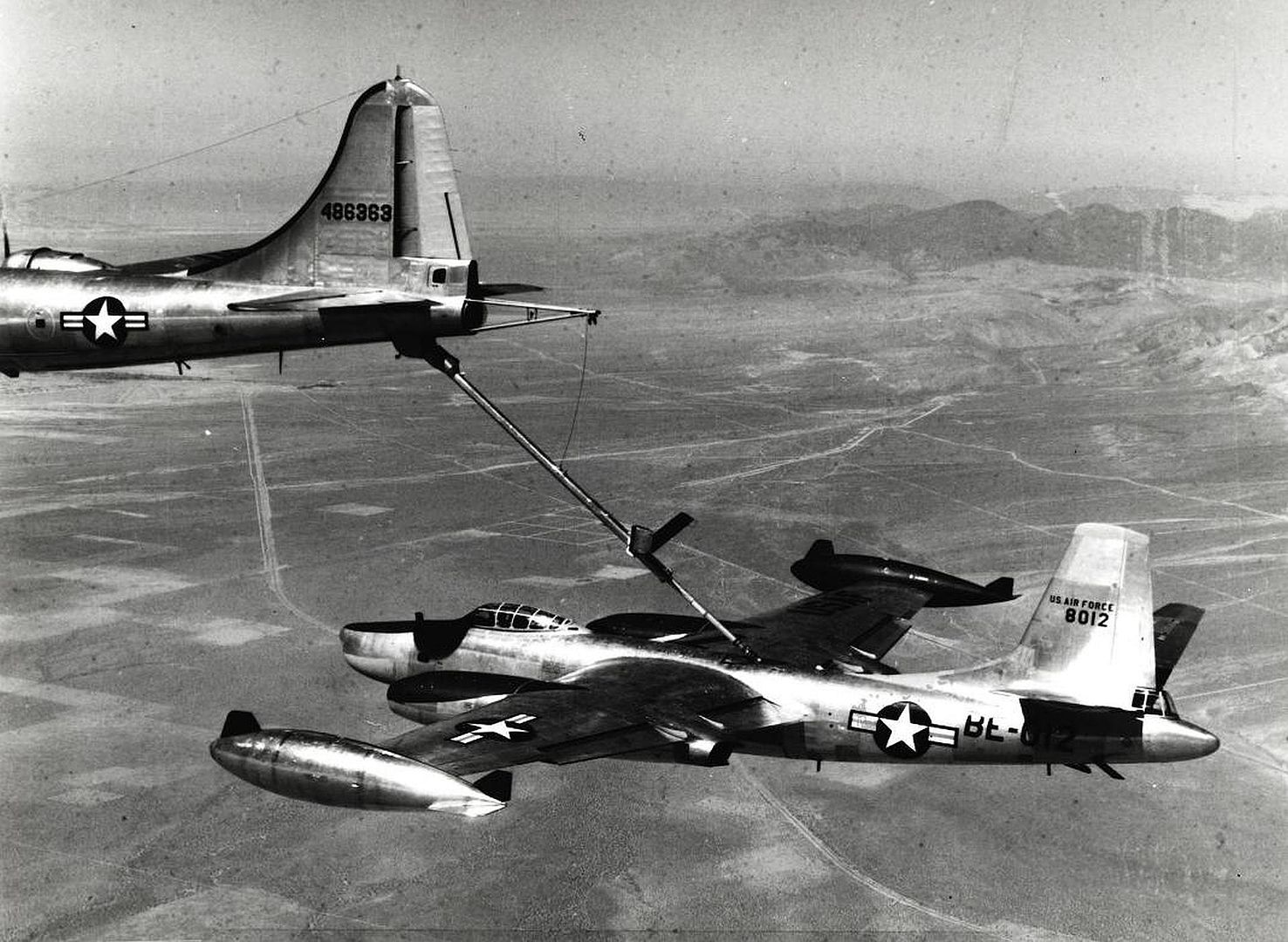
On July 29, 1952, A 91st Strategic Reconnaissance Wing RB-45C (48-042) commanded by Major Louis H. Carrington made the first nonstop trans-Pacific flight from Elmendorf AFB, Alaska to Yokota AB in Japan. There were two inflight refuelings by KB-29s along the way. This feat earned the 1952 Mackay Trophy for the crew.
RB-45C serial number 48-017 was modified for various flight test programs and was redesignated JRB-45C. A jet engine under test could be mounted in a retractable pylon underneath the bomb bay. The equipment bays which housed the camera equipment could be refitted to house test equipment.
In the later 1950s, the RB-45Cs were rapidly replaced by such aircraft as the RB-47E, and by mid-1959, only one RB-45C remained in the Air Force inventory.
Serials of RB-45C:
48-011/043 North American RB-45C Tornado
017 to JRB-45C
Specification of North American RB-45C Tornado:
Engines: Four General Electric J47-GE-13/15 each rated at 6000 lb.s.t with water injection. Alternatively, four J47-GE-7/9 engines rated at 5820 lb.s.t with water injection were provided. Performance: Maximum speed 570 mph at 4000 feet. Combat speed 506 mph at 32,700 feet. Initial climb rate 4340 feet per minute. Service ceiling 40,250 feet. Range 2530 miles. Takeoff ground run 6100 feet. Takeoff over 50-foot obstacle 8070 feet. Dimensions: Wingspan 96 feet 0 inches, length 75 feet 11 inches, height 25 feet 2 inches, wing area 1175 square feet. Weights: 49,984 pounds empty, 110,721 pounds gross. Armament: Two 0.50-inch M-7 machine guns in tail turret. 25 188-pound M-122 photoflash bombs could be carried in the bomb bay.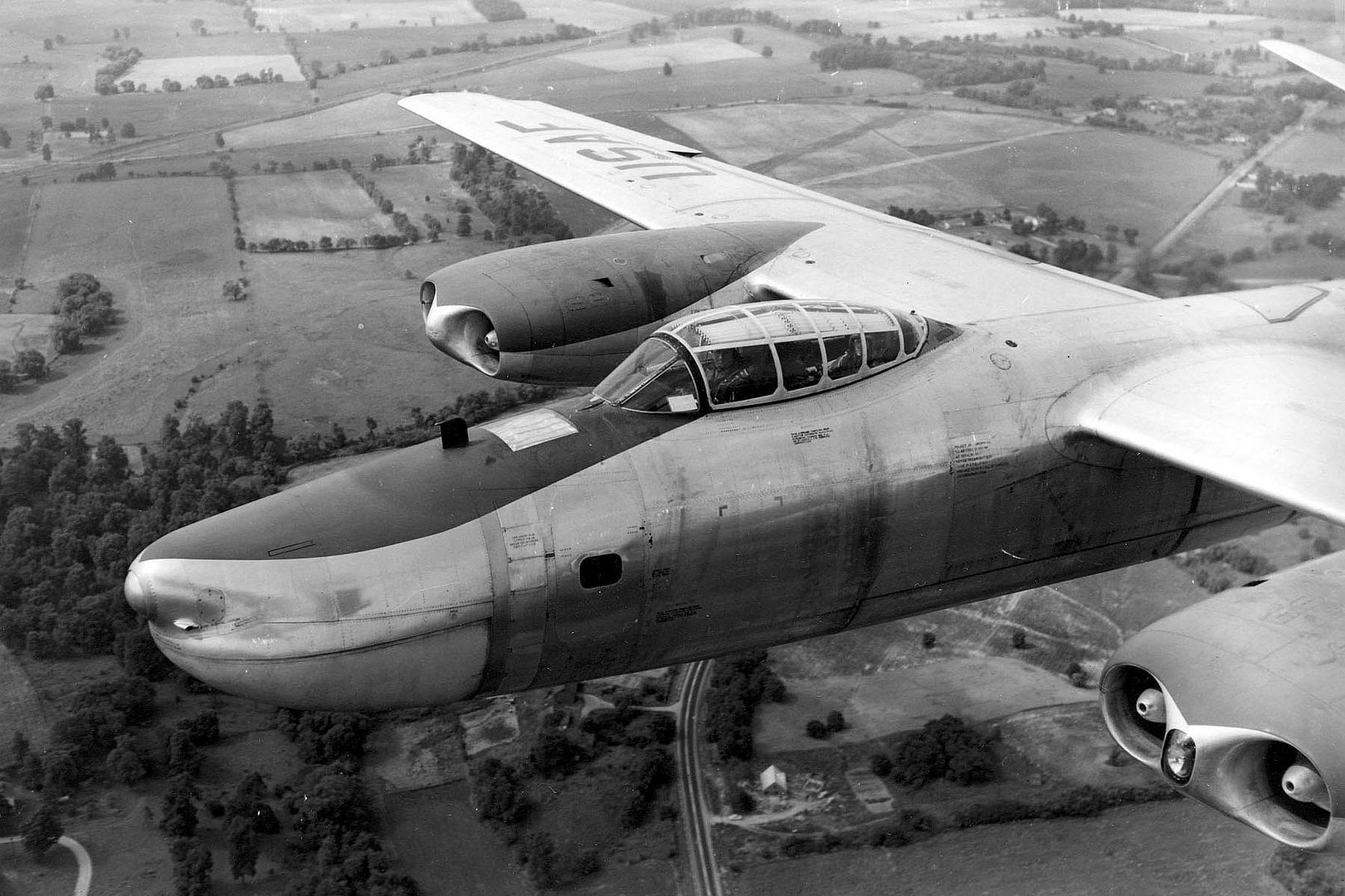
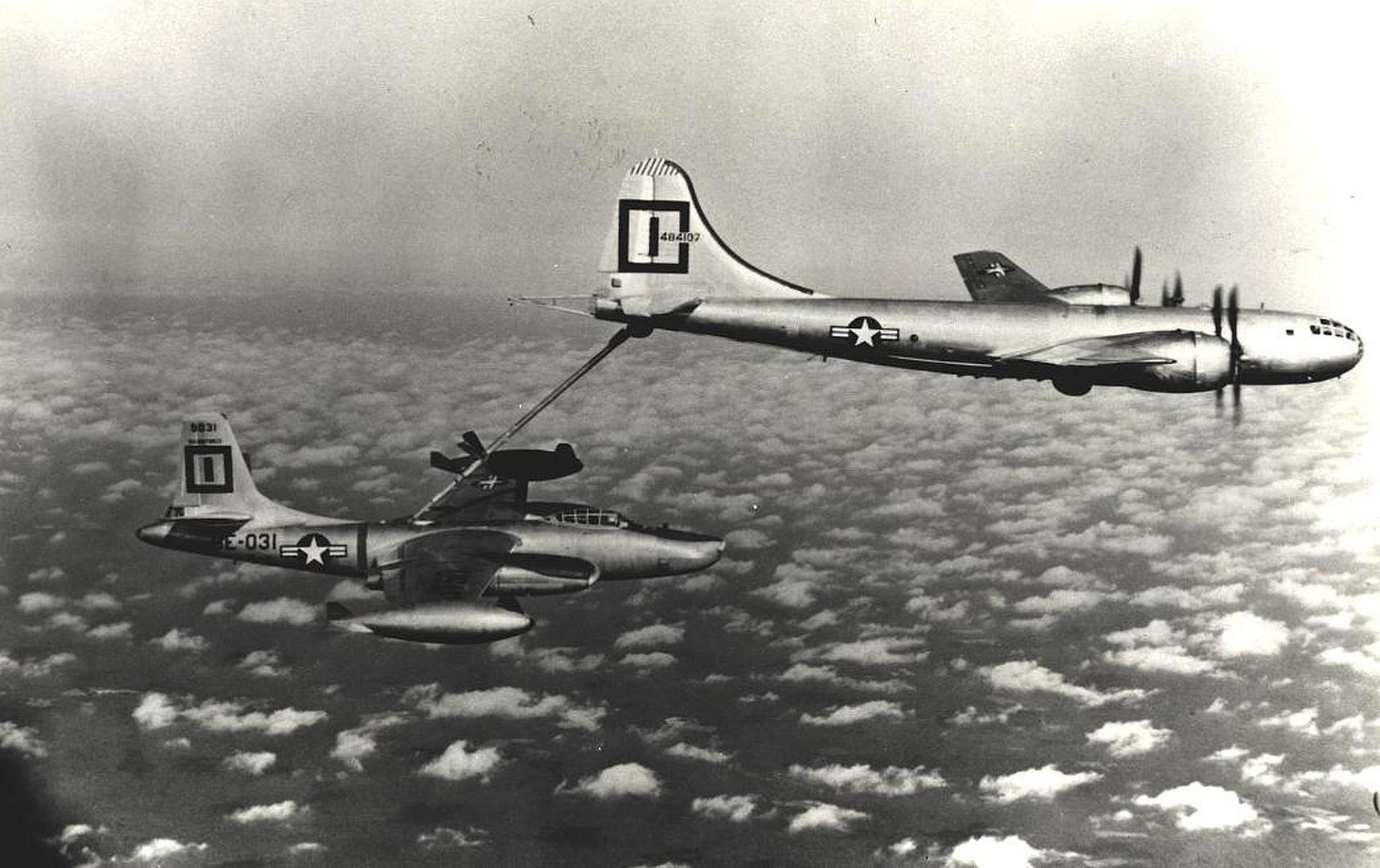
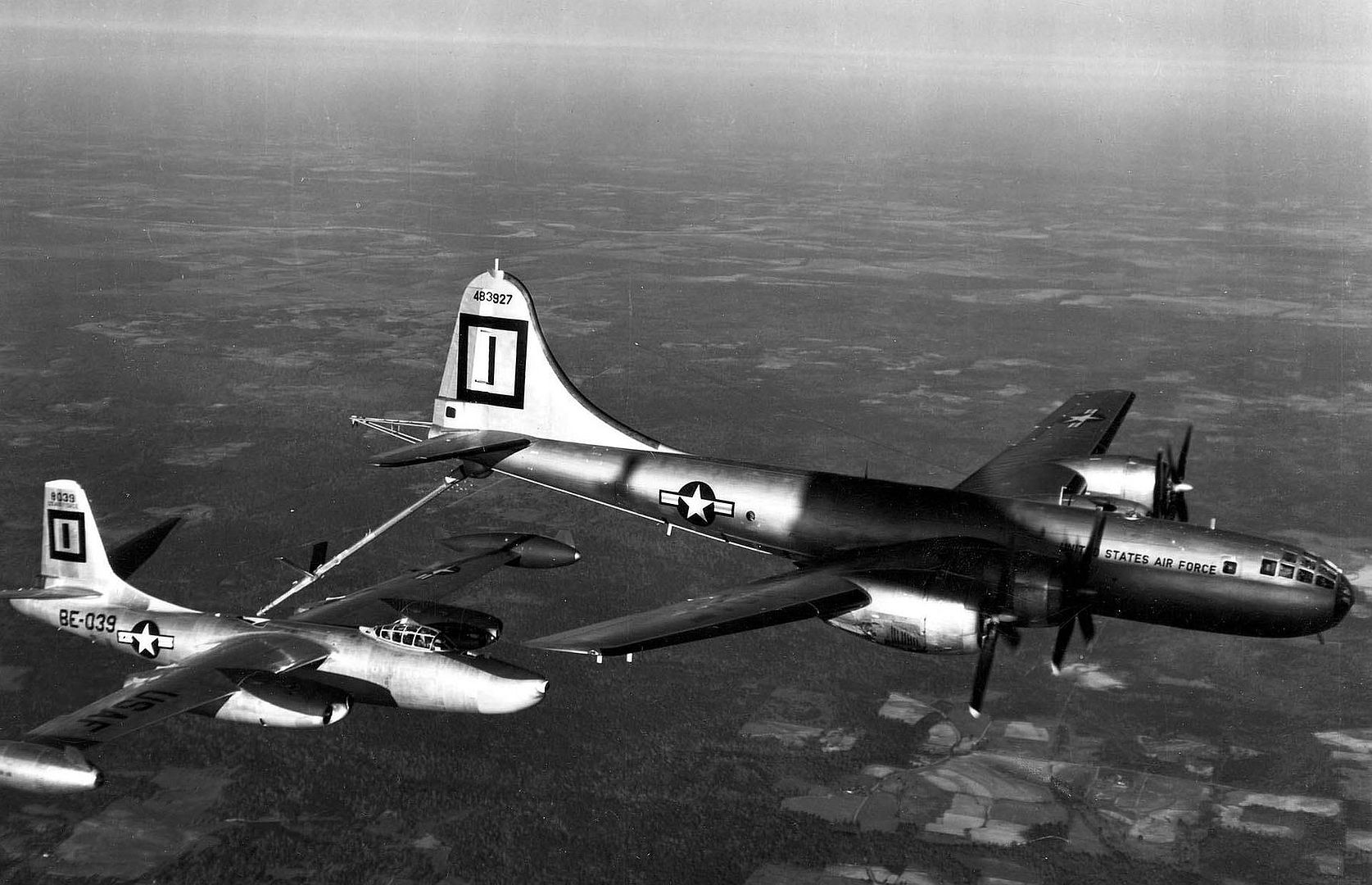

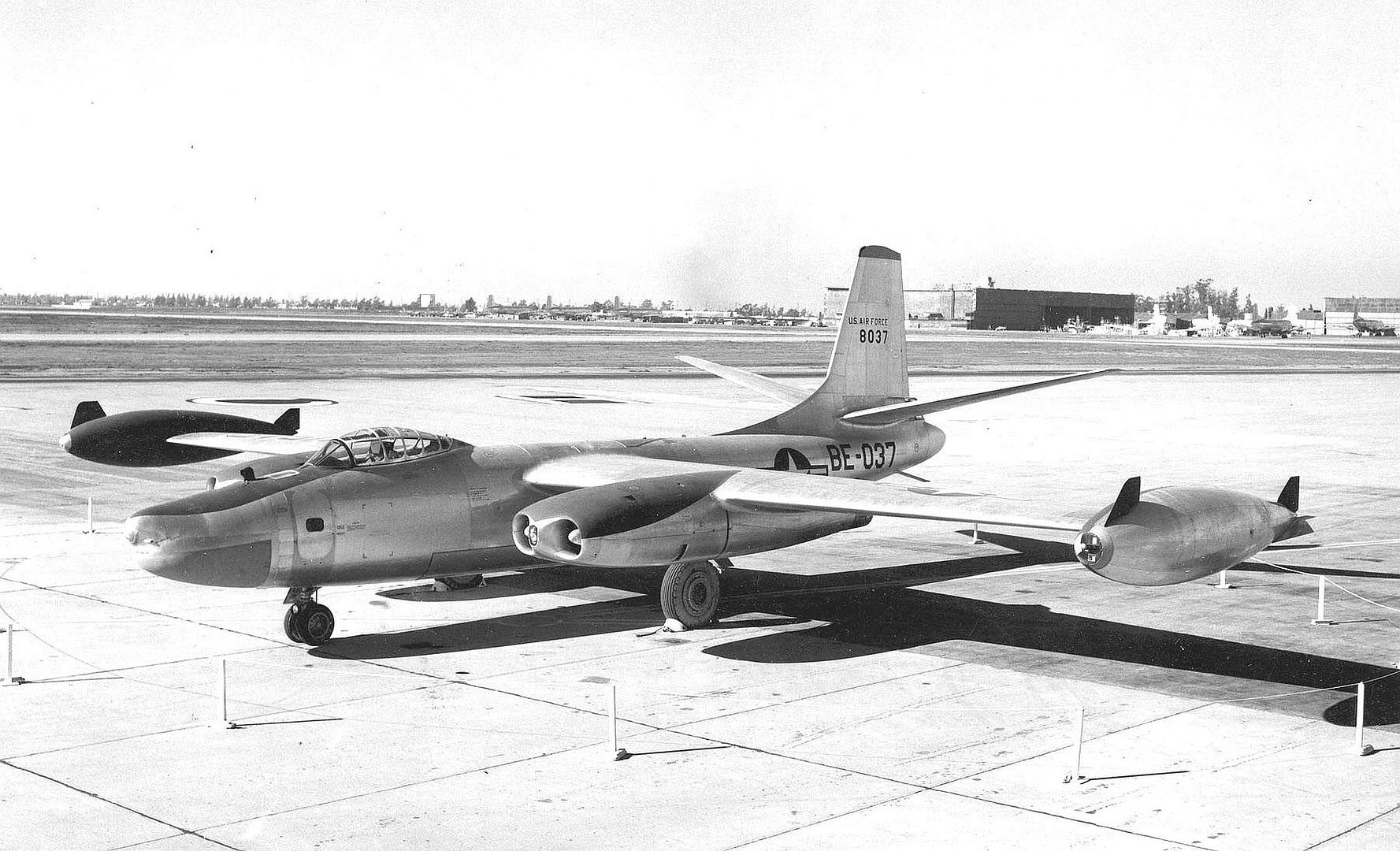
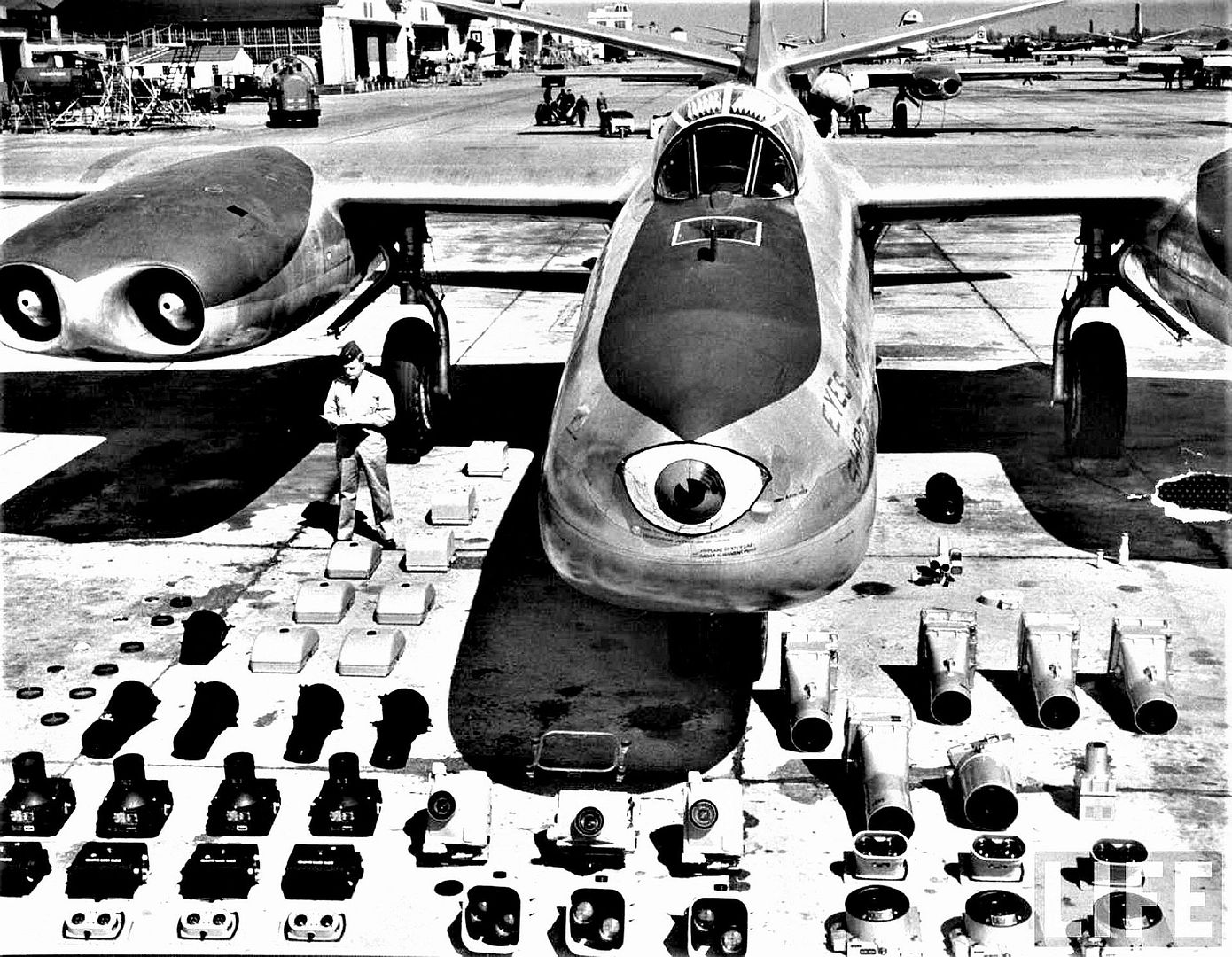
(text from here - ) http://www.joebaugher.com/
Post a reply
- Go to Previous topic
- Go to Next topic
- Go to Welcome
- Go to Introduce Yourself
- Go to General Discussion
- Go to Screenshots, Images and Videos
- Go to Off topic
- Go to Works in Progress
- Go to Skinning Tips / Tutorials
- Go to Skin Requests
- Go to IJAAF Library
- Go to Luftwaffe Library
- Go to RAF Library
- Go to USAAF / USN Library
- Go to Misc Library
- Go to The Ops Room
- Go to Made in Germany
- Go to Campaigns and Missions
- Go to Works in Progress
- Go to Juri's Air-Raid Shelter
- Go to Campaigns and Missions
- Go to Works in Progress
- Go to Skinpacks
- Go to External Projects Discussion
- Go to Books & Resources
